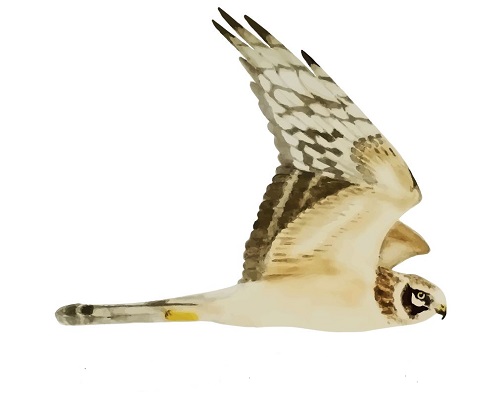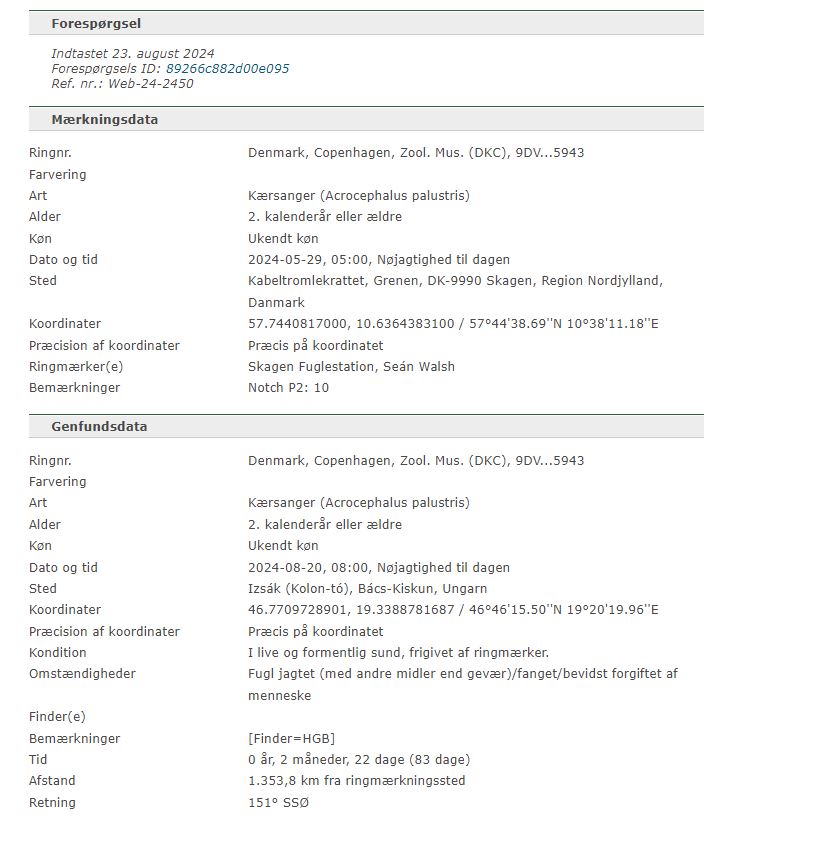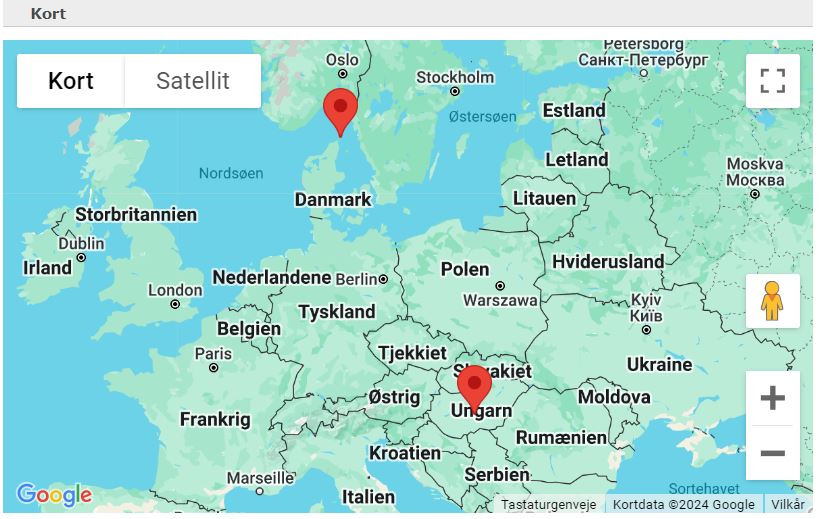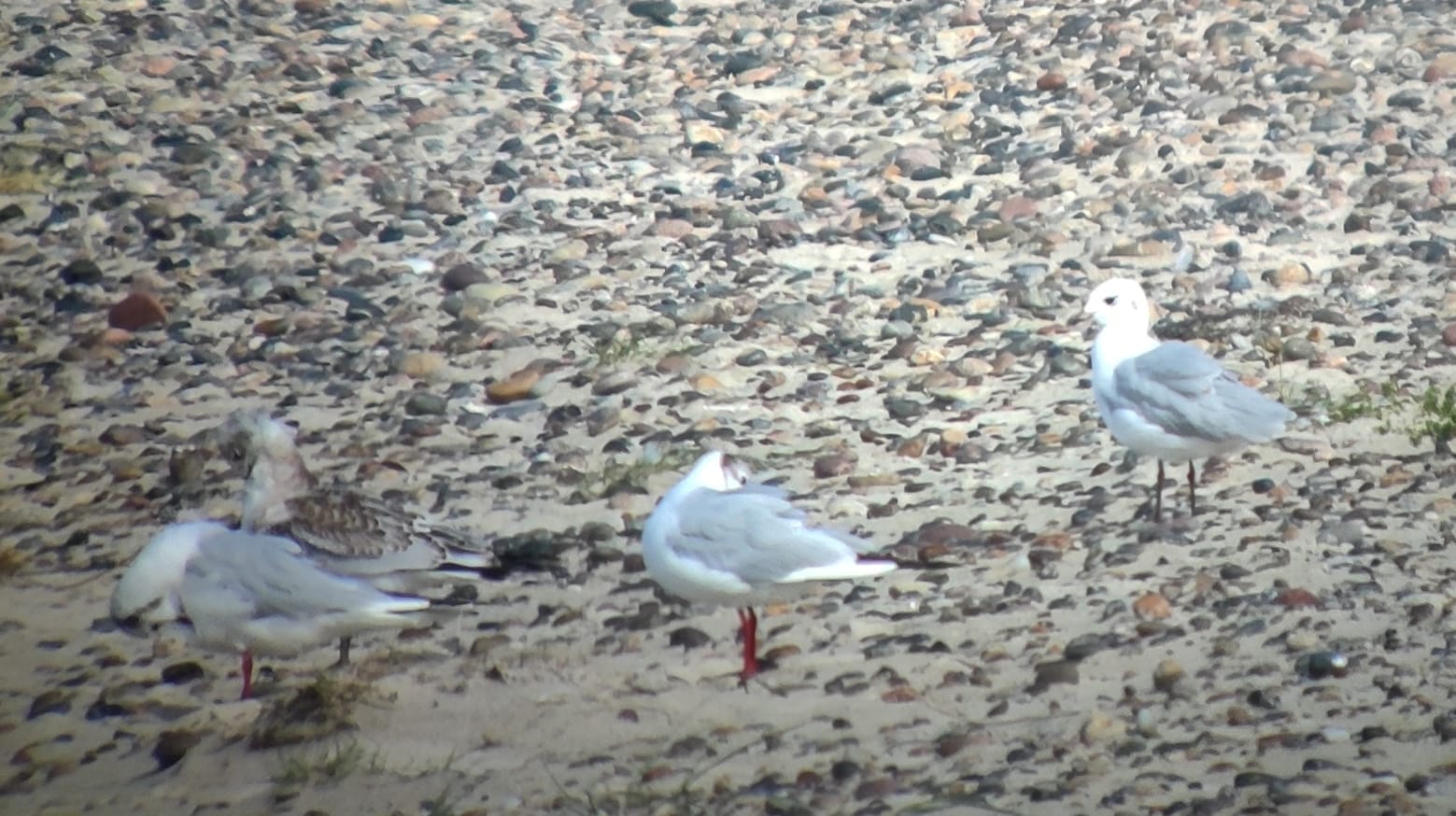Her på Skagen Fuglestations blog bringes korte nyheder i dagbogsformat om hændelser på fuglestationen.
I'm back!
Efter tre års fravær fra Skagen Fuglestation er jeg nu tilbage og så skal der jo selvfuglevis blive arbejdet hårdt igennem, for at finde nogle lækre fuglearter til nabolaget;)
Så sæt jer til rette, find en læskende drik og nyd en gammel kendings blog;)
Men inden vi går helt i gang skal I da ikke snydes for en vild nyhed!!
Ja, faktisk en ”førstegangs” i Skagen Fuglestations historie. Der er nemlig blevet genfanget en Kærsanger, som blev ringmærket her på fuglestationen!
Fuglen blev ringmærket den 29. maj og blev så genfanget den 20. august i Bács-Kiskun i Ungarn.
Inden vi går helt i gang med dagens strabasser, så får I også lige et hurtigt recap på hvad der skete af heftige sager nede i Himmerland i nat.
I nat var Simon, Andrew og Rosa nede omkring Ålborg for at prøve lykken med noget tredækker-fangst. Det lykkedes dem at se tre på to lokaliteter hvoraf de var så heldige at fange den ene af dem på nogle marker i Himmerland. Eftersom at vejrudsigten for dagen efter (i dag velogmærke (23. august)), så de forsøgte fangst længere ud på natten for så at få en overnatning hos Simons mor, som lavede dem lækker morgenmad:)
Nå, lad os så komme i gang med fuglefolkenes oplevelser for i dag:)
Ragnar og jeg havde valgt at blive hjemme for at forsøge noget obs og lusk. Vejrguderne var dog ikke med os og efter at vi havde vågnet hver halve time siden klokken fem, for bare at kunne se en vejrudsigt der sagde "røv og nøgler", da kom endelig et fald i vinden og et svagere regntryk. Vi kørte så ud mod Grenen og satte os i klitterne vest for Sandormesvinget. På vejen kunne jeg glæder mig over en ny Danmarksart; nemlig den stationære Cistussanger, som blev fundet af Rolf Christensen omkring den 14. august. Det blev min art nummer 383 i Danmark.
Obsen gav ikke det helt store, men efter endt obs tog vi ud for at tælle småfuglefaldet. Havde kørt med skopet og scannet krattene i reservatet og Grenen for at blive mødt af krat levende med småfugle!
Af nævneværdige fugle fra obsen og lusketuren kan nævnes:
Cistussanger,
Sorthovedet måge 3 ungfugle
Kaspisk måge 2 ungfugle
Broget fluesnapper 2
Og så en lille joker(?)
Under lusken hørte Ragnar og jeg lige pludselig nogle sylvia-kald, som skilte sig markant ud ift. de omkringværende gærdesangere. Ja, den skilte sig så meget ud at vi begge to stod måbende, fordi at vi begge to havde en mavefornemmelse der sagde ”HIT!”.
Mens den kaldte løs på livet løs, gik vi hurtigt ind for at tjekke kaldende på vestlig og østlig hvidskægget sanger, og ja, der var et match! Faktisk matchede vestlig hvidskægget sanger rigtig godt! Vi blev ved med at høre den, men ikke se den, og grundet vind og vejr og rent adfærdsmæssigt for nogle af fuglene, og sjovt nok også inden for den art (idet at de godt kan lide at trykke sig/fouragere dybt nede i et krat), så så vi den aldrig. Så både Ragnar og jeg tigger og ber’ til at den bliver taget i ringmærkningen i morgen!
Der blev gjort et forsøg på at genfinde den med assistance fra Rosa, dog uden nogen fortjeneste at kunne dele med resten af birder Danmark.
I morgen tager Ragnar og jeg ud på morgenobs og Rosa, Simon og Mette tager mærkningen ved Kabeltromlen. Det bliver en god dag…
Folk ved stationen:
Ragnar Smith, Rosa Hicks, Simon Sigard Christiansen, Mette Møller Christensen og Frederik Johansen.
Raining Cats and Dogs... and Wheatears
Hi folks!
In the UK, we have the saying “it’s raining cats and dogs” for heavy rain. I’ve asked Fredrik, and he says in Denmark, “det star ned i stænger” is more popular than “det regner med katte og hunde!” But, regardless, rain is certainly what it did today.
The rain came in from about 7:30, so we closed the nets at Kabeltromlen after 2 net rounds, and a mere 6 birds. Meanwhile, Ragnar was on observations and had reported migrating passerines moving in from the sea to avoid the poor weather conditions. This included a red-backed shrike (Rødrygget Tornskade), which he spotted from quite some distance. Hearing the news of these landing passerines, me and Ragnar headed out to Elle Krattet to see what was seeking refuge in the woodland. Between us we noted 8 spotted flycatchers (Grå Fluesnapper), 2 pied flycatchers (Broget Fluesnapper), 3 common redstarts (Rødstjert), 1 icterine warbler (Gulbug), a few whinchat (Bynkefugl), and over 30 wheatear (Stenpikker)!

A lesser whitethroat (Gærdesanger) in the beautiful Kabeltromlen sunrise.
Today was Andrew’s last day, so while we were out looking for passerines across Buttervej and beyond, he was buying souvenirs – mainly in the form of lots of licorice! But while we will be saying goodbye to Andrew tomorrow, we were joined by the lovely Fredrik Johansen, who is keen to be back at the station.
We then got on with some admin tasks before setting off Aalborg-bound for another night of great snipe (Tredækker) catching. With the car packed with slightly more jackets and coffee than last time, we drove south, where we met Sean. There were fewer birds about this visit, and the wet weather made spotting the birds difficult in the thermal. However, we caught a great snipe (Tredækker), a common snipe (Dobbeltbekkasin), and 2 skylarks (Sanglærke). It was especially nice to be able to see the great snipe next to the common snipe and observe the morphological differences. We only saw 3 more great snipe, so it seems a few have moved on with their migration, leaving the sites. We’re hoping the younger birds could still be yet to pass through in the coming weeks.
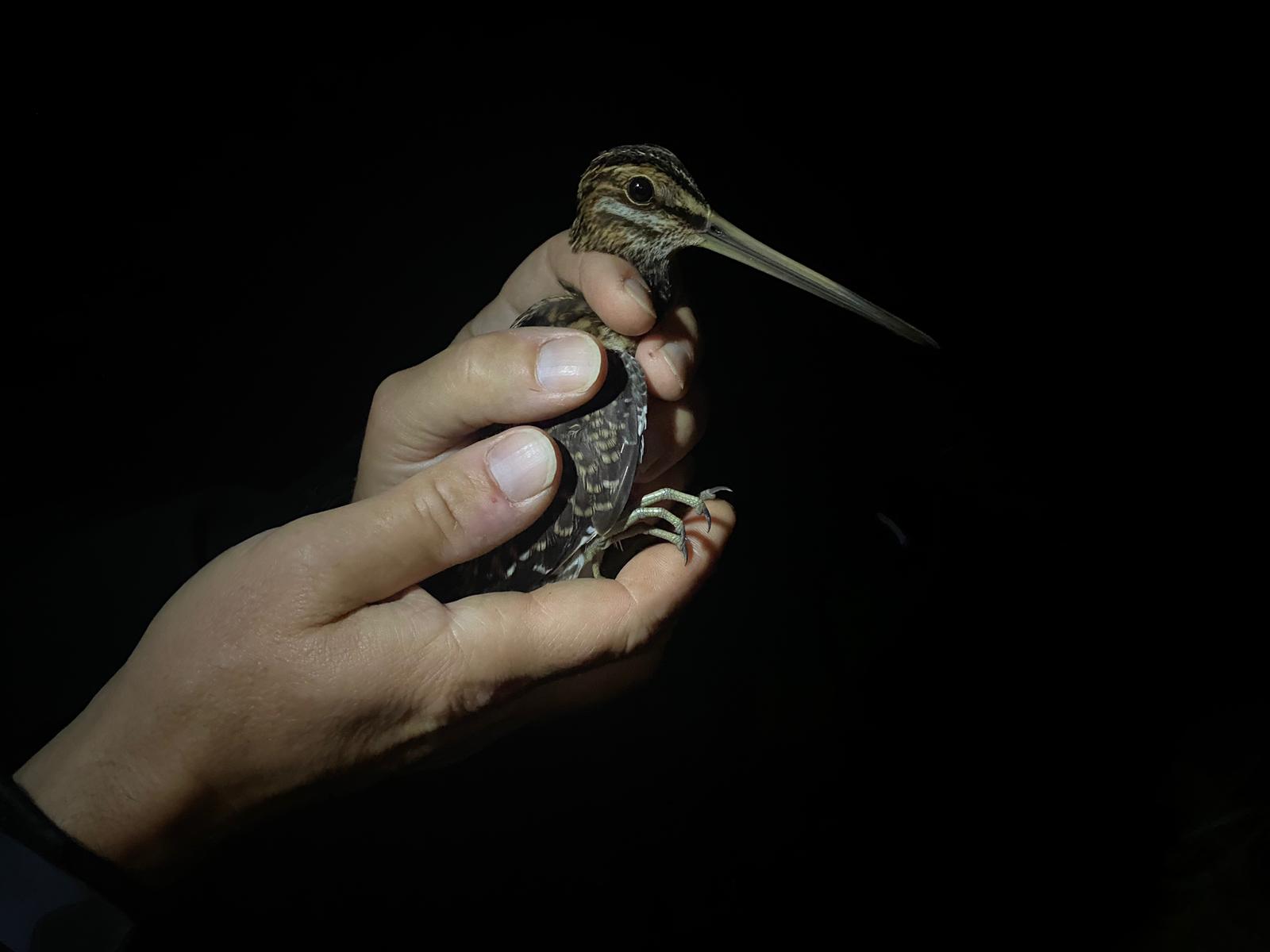
A first year common snipe (Dobbeltbekkasin), photographed before being released.
We were grateful to Simon’s mum, for kindly offering us drinks and biscuits before heading out as well as a place to stay at the perfectly reasonable bedtime of 5am – thank you!

The team doing some essential preparation before the night catching.
Ringing (Kabeltromlen)
Tornsanger: 1
Løvsanger: 2
Rørsanger: 2
Gærdesanger: 1
Ringing (Lindenborg)
Tredækker: 1
Dobbeltbekkasin: 1
Sanglærke: 2
Ringing Total: 10
Link to todays observations from observers in the area
People at the station: Ragnar Smith, Rosa Hicks, Andrew Commins, Fredrik Johansen, Sean Walsh, Simon Sigard Christiansen.
Wednesday is for cake and sleeping in
Yesterday we said goodbye to Lucas and Joseph (womp womp), now we are three volunteers left at the station so we are waiting for the next volunteers to arrive shortly.
But today we could sleep in a bit, with heavy rain making counting and ringing a difficult task. But at 0930 we went out to the sandworm track to do some counting as the rain stopped. It didn’t result in any notable migration but highlights were a Short-eared Owl (Mosehornugle), the continuing Zitting Cisticola (Cistussanger), Arctic Skua (Almindelig Kjove) and four Mediterranean Gulls. This season is turning into a possible record autumn for this scarce species with at least 9 different individuals having passing through Grenen since 15th July.
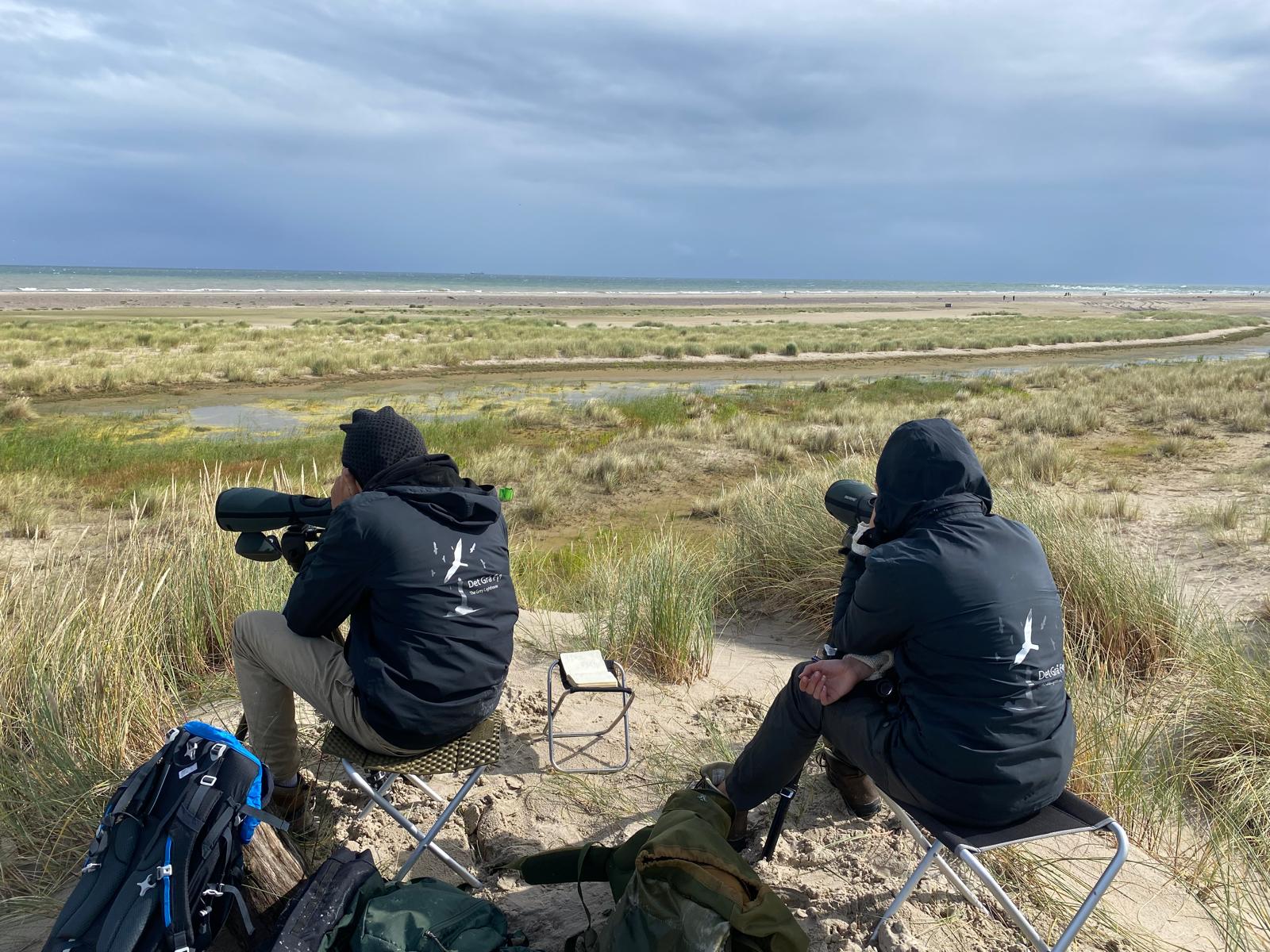 Two hours of counting looks like this
Two hours of counting looks like this
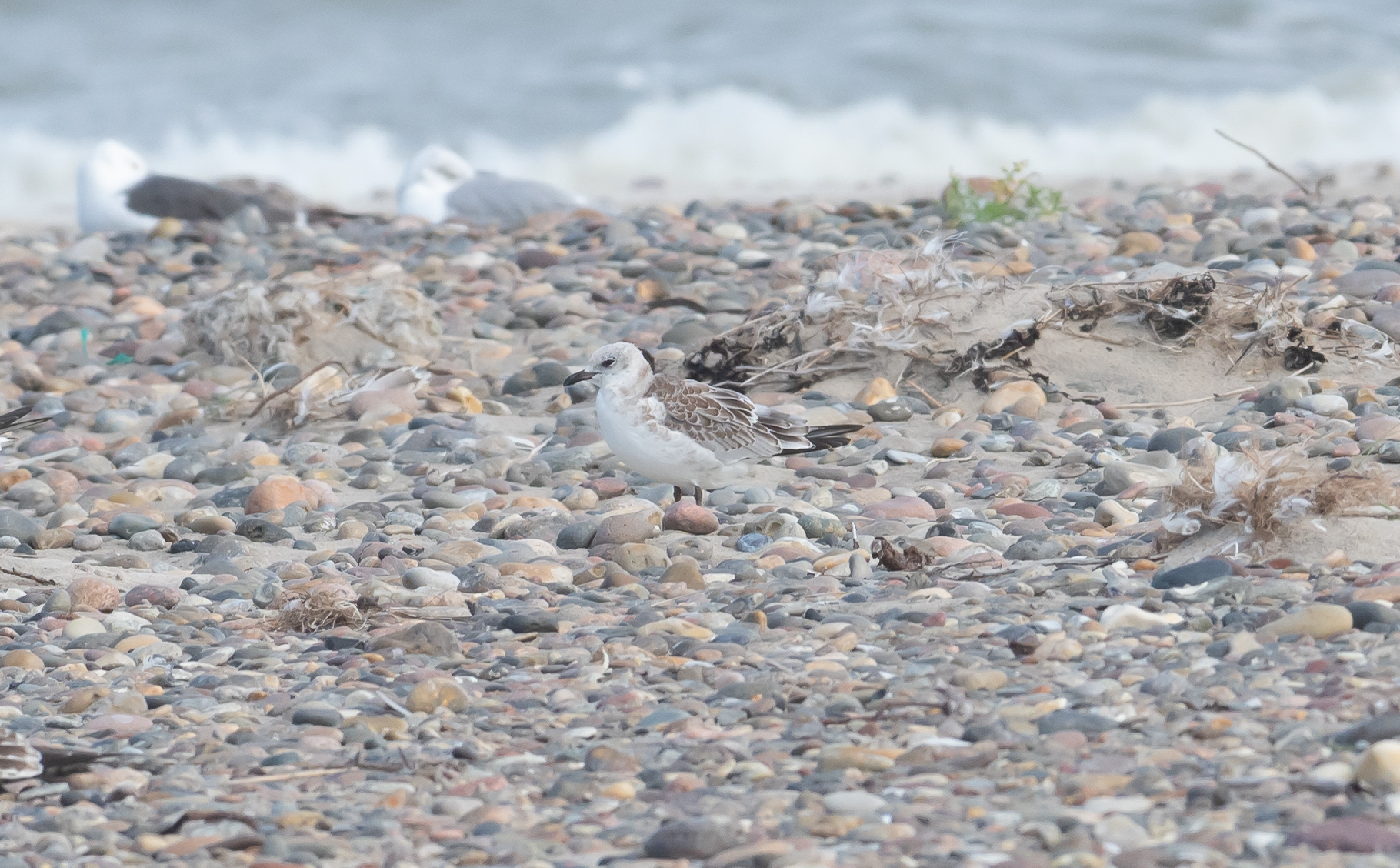 Mediterranean Gull 1k, always good to see this scarce migrant
Mediterranean Gull 1k, always good to see this scarce migrant
While we were out Simon was doing a small tour for some visitors, and when he were done with migration count and he was done with tour, we went out to Gyvelmarkerne with the guests next door and after that to Lidl to do some shopping. Gyvelmarkerne didn’t yield anything crazy, but we found a Wasp Spider (Hvepseedderkop) and Natterjack Toad (Strandtudse) as the highlights.
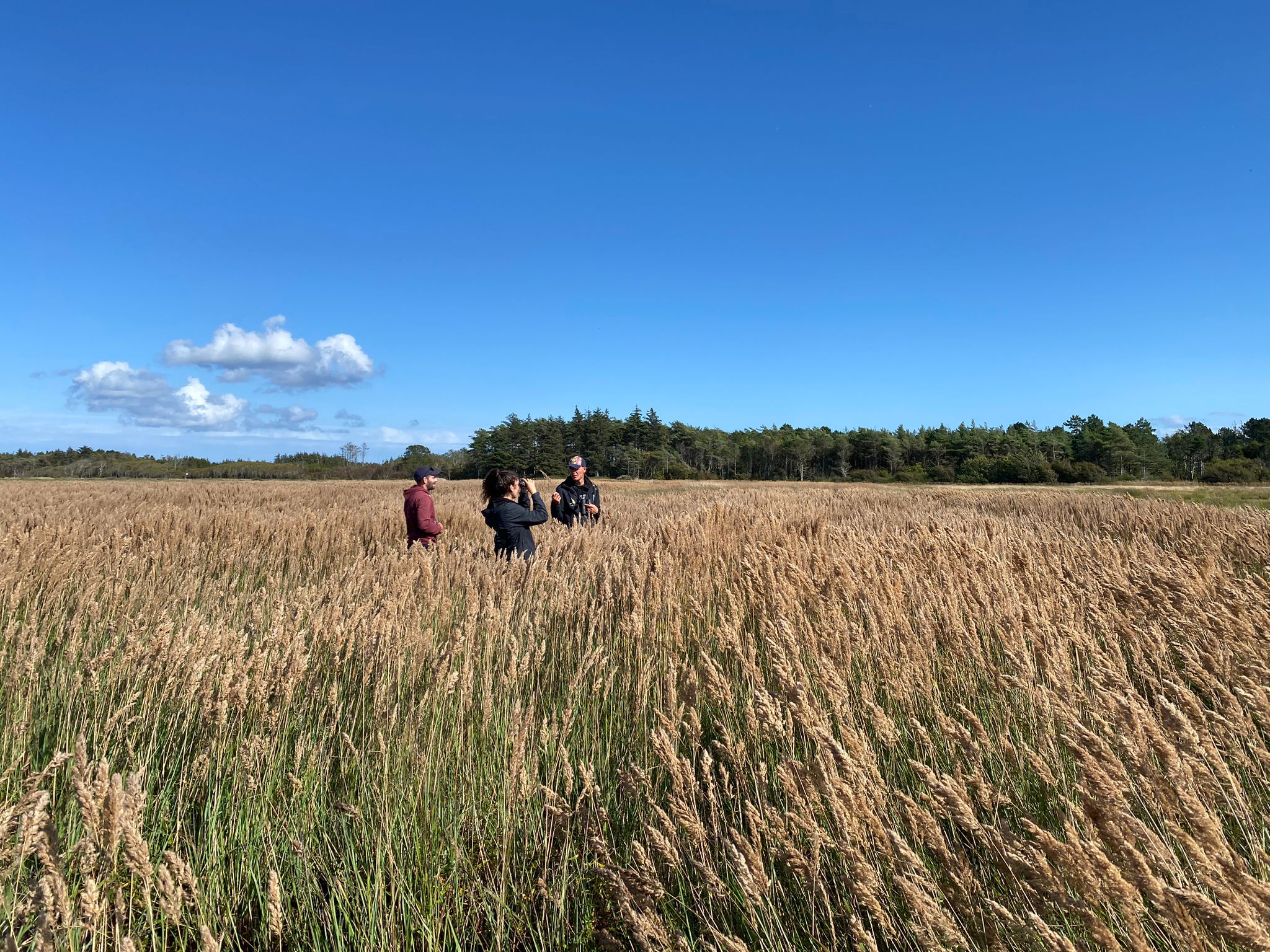 The stomping grounds of the few and proud: Gyvelmarkerne
The stomping grounds of the few and proud: Gyvelmarkerne
After that we had some down time and Simon showed us a game he uses to teach visitors on his guided trips, where you to match different body parts of birds and animals with right pictures, that was quite fun, but we didn’t all of them right and Simon said after he would have gotten us ice cream if we did. Maybe if he told us before, we would have been a bit more motivated.
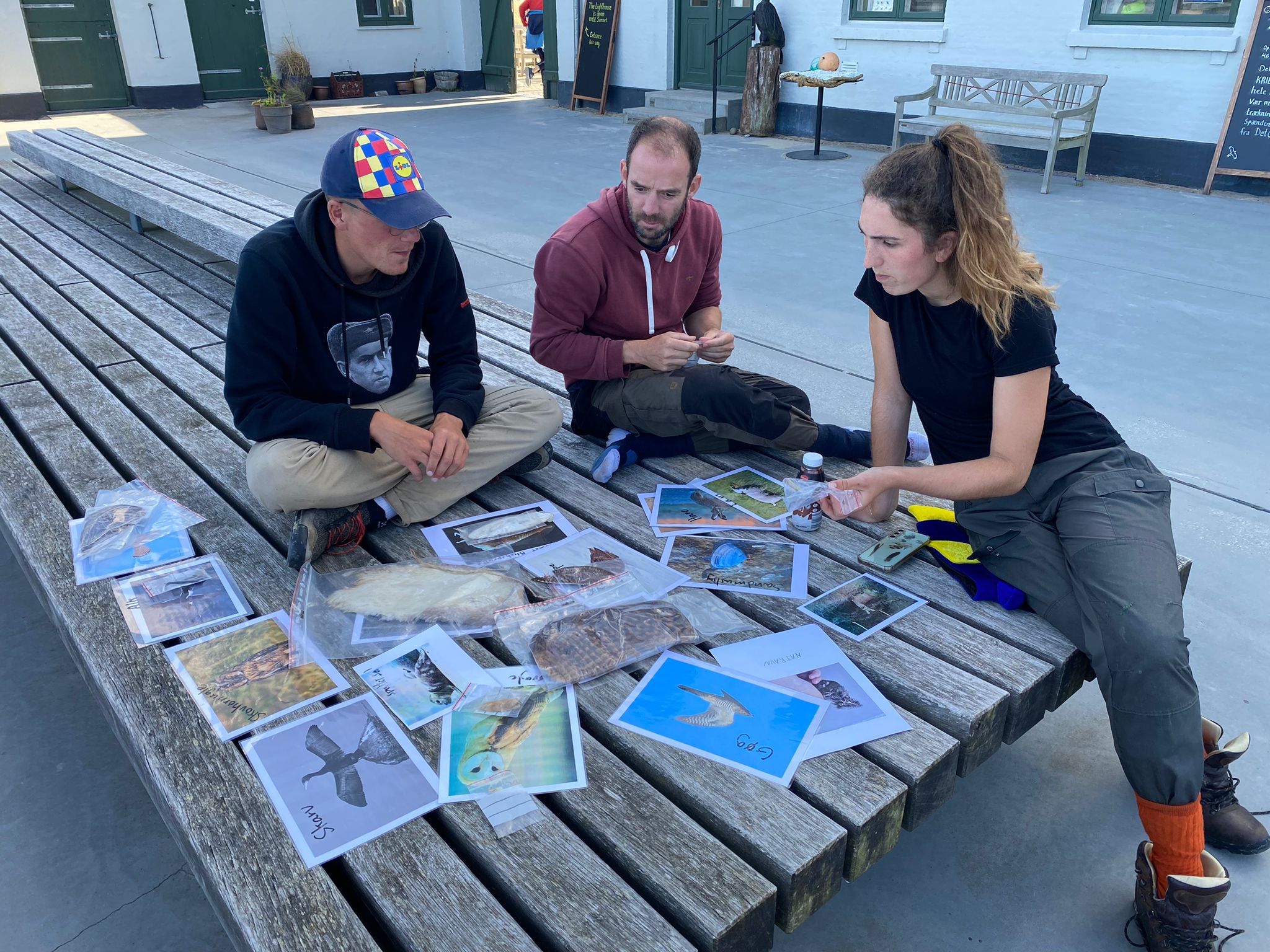 Doing build-a-bird
Doing build-a-bird
Dinner was cooked, a cake was baked and sunset trip to the top a lighthouse was a nice way to end the day. Tomorrow we return to normal schedule and we will get a new volunteer, Frederik Johansen, who will help us with the counting for a week. The more the merrier
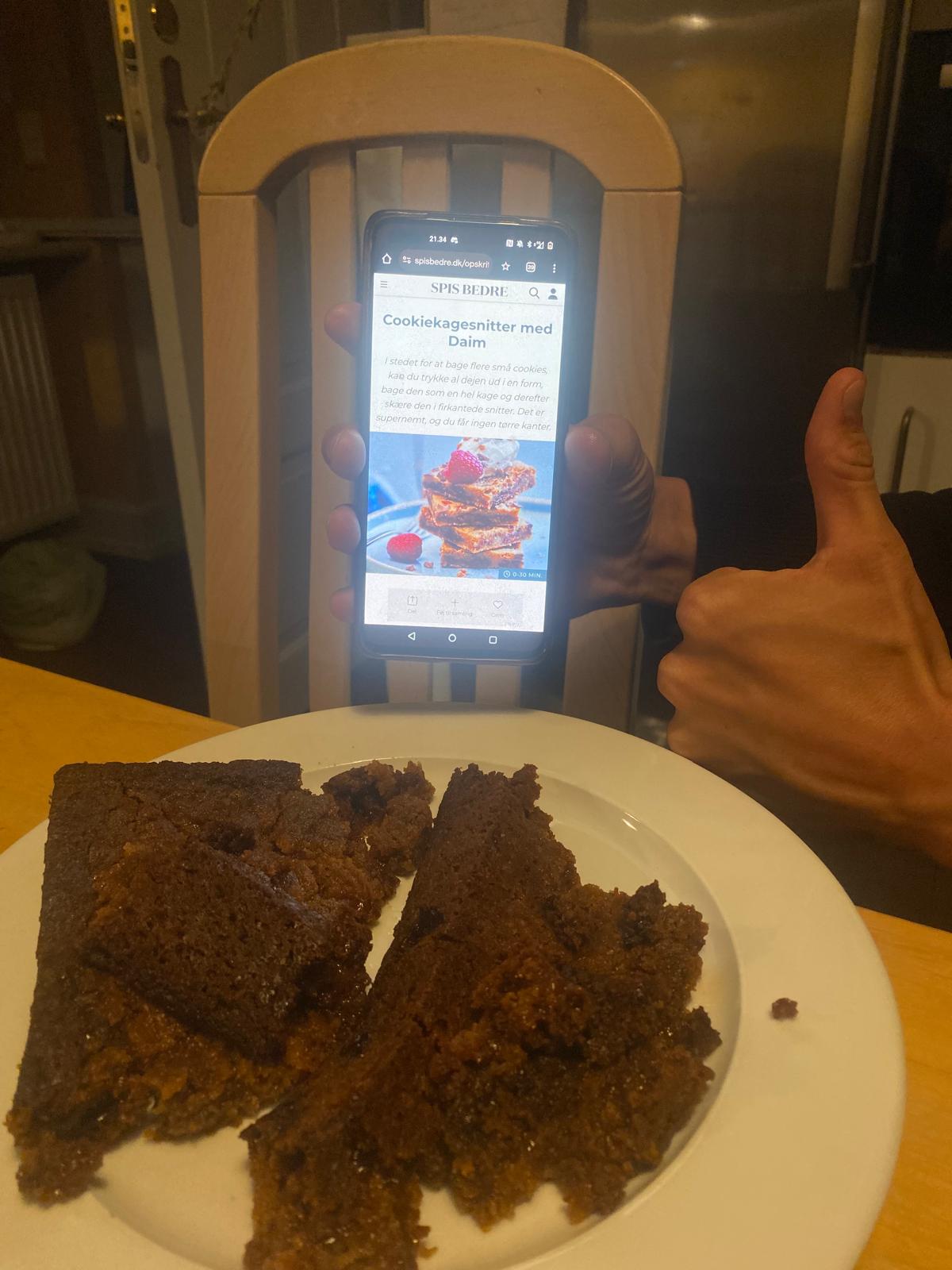 Same same but different, still tasty!
Same same but different, still tasty!
Ringing (Kabeltromlen)
Total: 0
Link to today's observations from observers in the area
People at SKAF: Ragnar Smith, Rosa Hicks, Simon S Christiensen, Andrew Commins, Susanne Præst, Torben Præst
A great night for a great snipe
Hi folks!
Once again, this blog begins with last night! The team (minus Joe), were off on an intrepid adventure south of Aalborg to catch great snipe (Tredækker)! Filled with instant coffee and optimism, we took to the dark fields with our hand nets and torches like sword and shield. After seeing several great snipe, it was great to be able to catch one – a lifer for the majority of the team. More importantly, catching it allowed us to take biometric data on this cryptic species to add to international databases. This one was an adult, and likely a female based on its shorter measurement of bill and head.
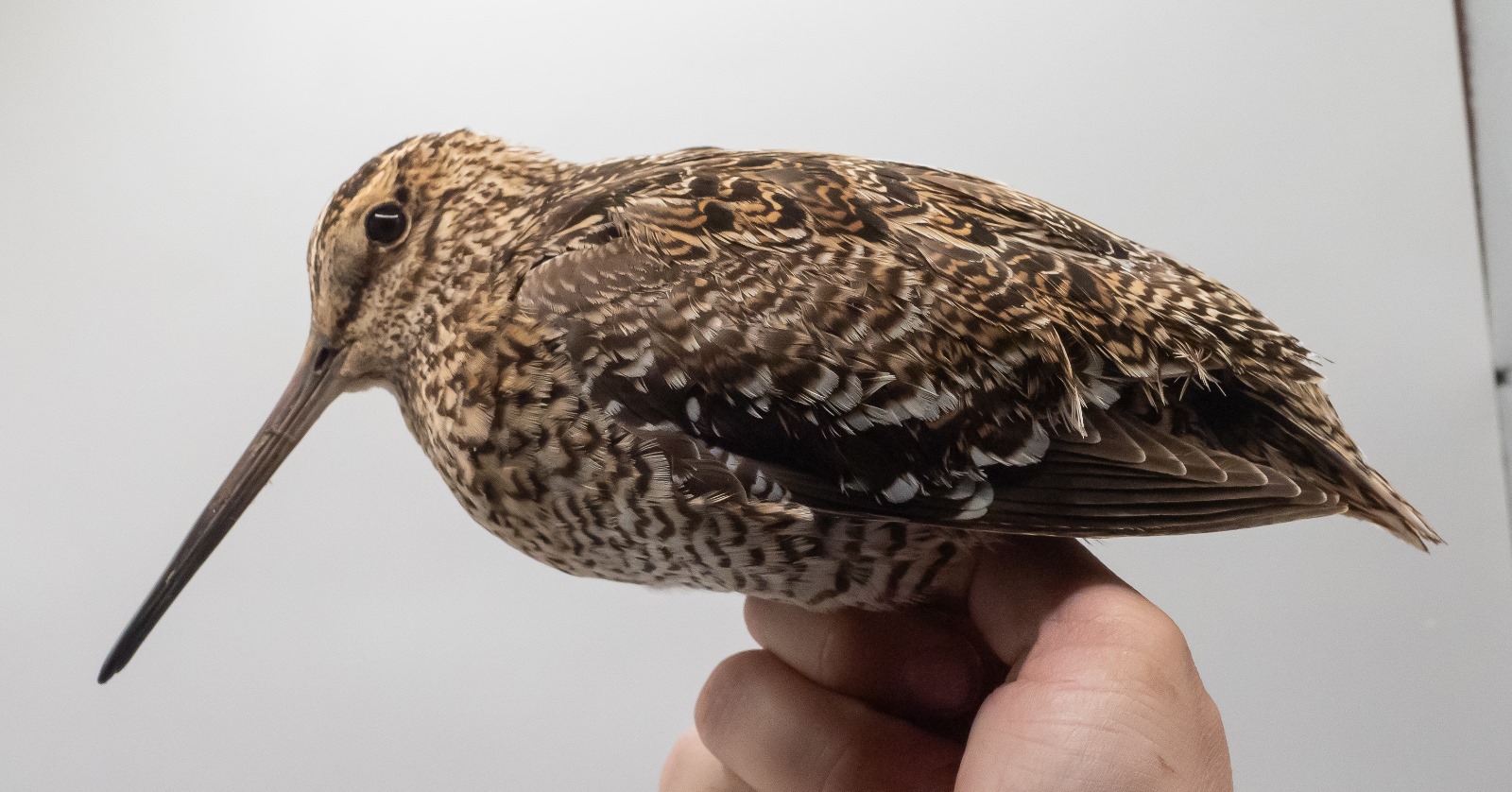
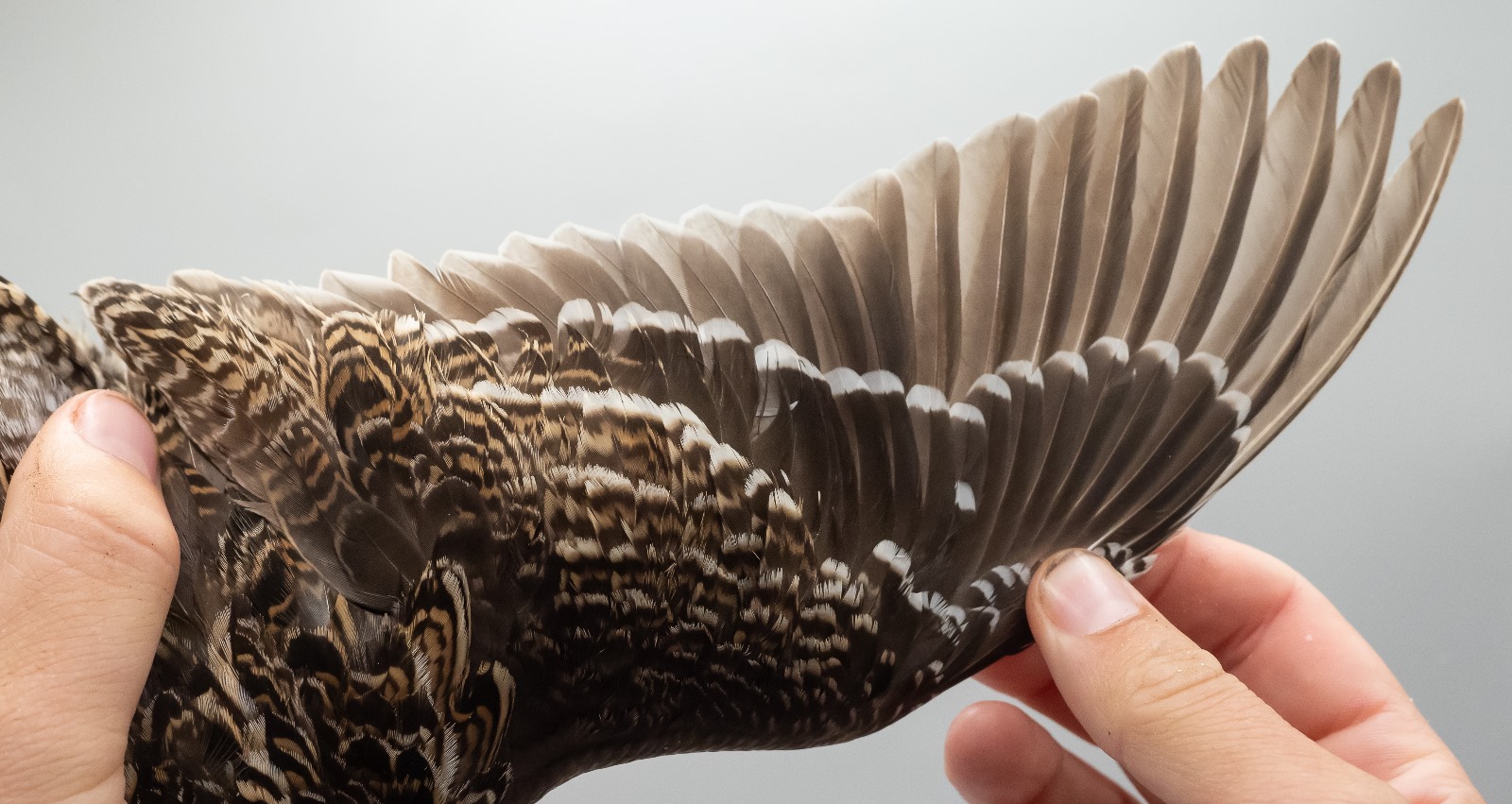
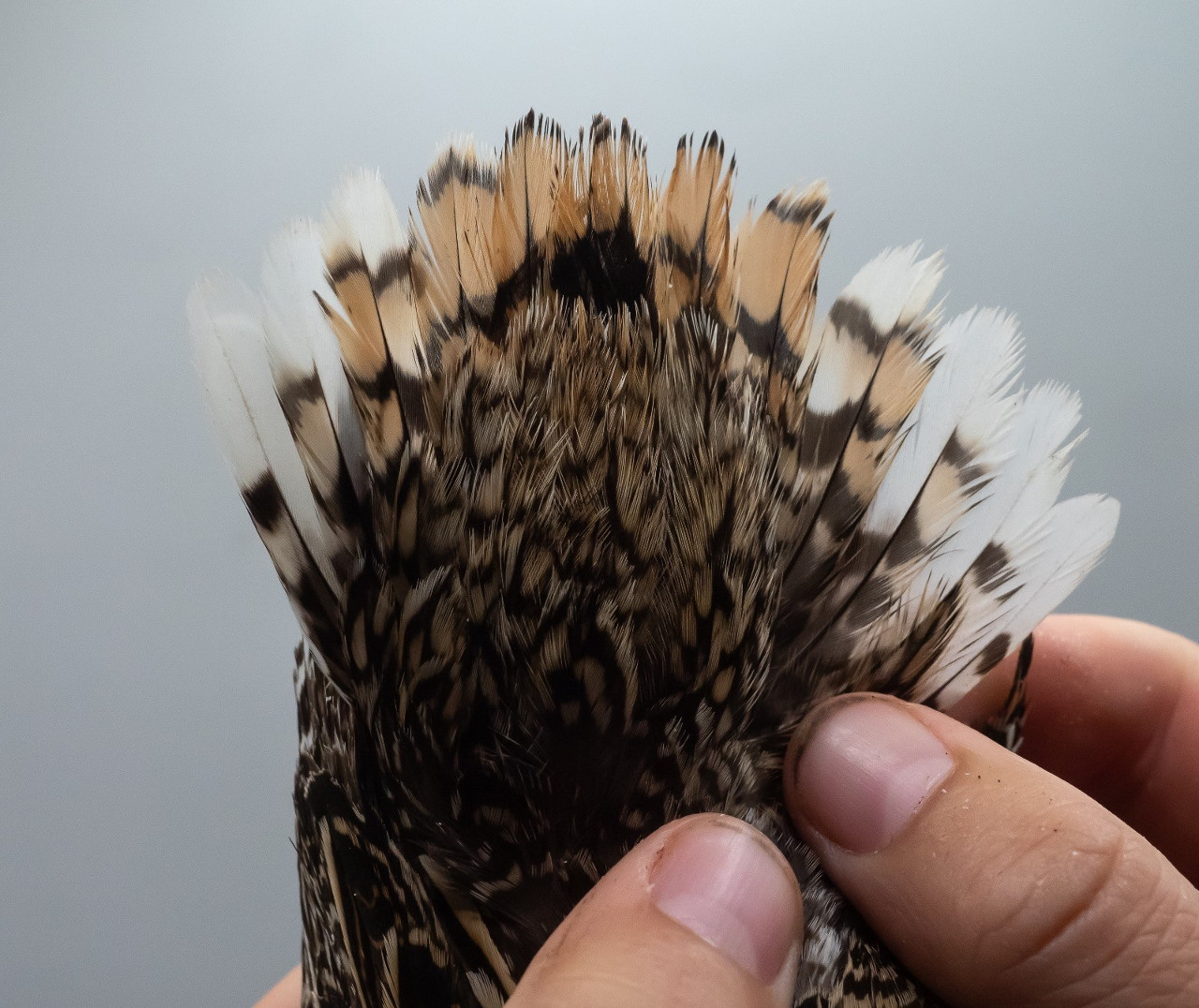 The adult Great Snipe (Tredækker), showing its profile, upper wing and tail pattern.
The adult Great Snipe (Tredækker), showing its profile, upper wing and tail pattern.
Between prospecting fields with the thermal for great snipe, and catching great snipe, we were able to take turns napping in Simon’s car and dreaming of great snipe. After a long night, we finally made it back to Skagen, where we headed straight out for ringing and observations.
Joe had kindly opened the nets, which had caught a first year pied flycatcher (Broget Fluesnapper) in the first round. The following rounds were slow, but luckily, we were kept company with plenty of guests, some of which brought cake! The session finished with a beautiful female yellowhammer (Gulspurv), with many of the team seeing this species up close for the first time.
Ragnor had a quiet day of migration, with waders making up the bulk of the passage birds, including 40 golden plover (Hjejle). He also spotted four mediterranean gulls (Sorthovedet Måge) and a single gadwall (Knarand). However, the star of the show was a yellow legged gull (Middelhavs-sølvmåge), picked out among the gull flock, a species Ragnar has been looking for all month!
After morning ringing, observations, and a few hours of data entry, chores, and admin, it was time to wish our American volunteers well on their long journey back across the pond to the states. Thank you for all the fun memories Lucas and Joe! We look forward to seeing what you get up to in the future.
Ringing (Kabeltromlen)
Rørsanger (Reed Warbler) – 2
Gærdesanger (Lesser Whitethroat) – 1
Gransanger (Chiffchaff) – 1
Tornsanger (Greater Witethroat) – 1
Gulspurv (Yellowhammer) – 1
Broget Fluesnapper (Pied Flycatcher) – 1
Ringing (Volsted Kær)
Tredækker (Great Snipe) – 1
Total: 8
Link to todays observations from observers in the area
People at the station: Ragnar Smith, Joseph Zeno, Lucas Corneliussen, Rosa Hicks, Simon Siggaard Christiansen, Andrew Commins, Susanne Præst, Peter Sørensen, Massimo Prosdocimi.
Americans on the Move
Today was a very bittersweet day for me. It was officially my last full day here at Skagen Fuglestation for the 2024 season. Not to fret dear readers, I will make my triumphant return in 2025 just you wait.
The day started off bright and early at Kabeltromelen with overall very few birds but a few good experiences with species I won’t be seeing for the foreseeable future. A nice comparison between an adult (2k+) and a hatch year (1k) Willow Warbler (Løvsanger). In total we caught 12 birds today which may not be the highest number in our history but it was nice nonetheless. But for the sake of Rosa and the rest of the ringing crew, I truly wish for their sakes it begins to pick up in pace over the next few days. On the observation front, Ragnar once again manned Worlds End 3 and had overall little other than three Mediterranean Gulls (Sorthovdet Måge), a European Shag (Topskarv) and the continuing Zitting Cisticola (Cistussanger).
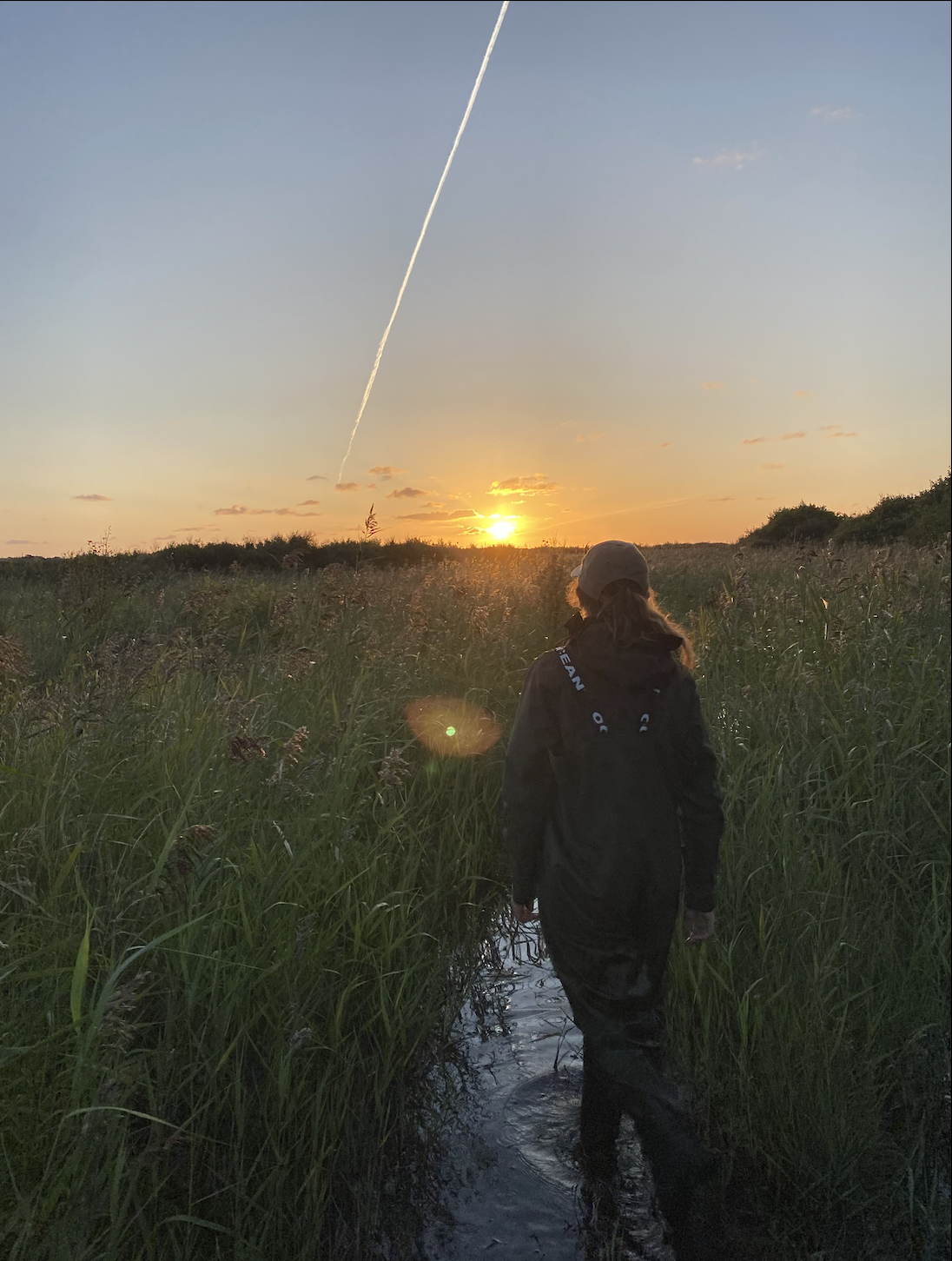
The remainder of the day continued to be quiet day - a swim was had, data was entered and lots of food was consumed and made to tidy us over for the remainder of the day. I had a short appointment in town that I needed to attend to, but after, I went over to Netto to get some ingredients for my final dinner of my stay - lasagna. We had to eat quite early as we were leaving at 6 PM to go to Aalborg in search of the semi-mythical Great Snipe (Trekædder). Joe opted to stay back to sleep and prep for the trek home, but in my dedication I decided to brave it and head south with the crew. Arriving at a birding locality just south of Aalborg, we looked for a breeding pair of Black-necked Grebes (Sorthalset Lappedykker). We then headed over to Simon’s fathers house for some cake, coffee and beer before heading out. Arriving at the predetermined locality we flushed 2 snipes without success and on the third attempt nearly 3 hours in, Simon and Rosa connected with one!! An adult (2k+) bird which we were able to ring and observe up close. Quite the way to get a lifer (for Rosa, Andrew and myself).
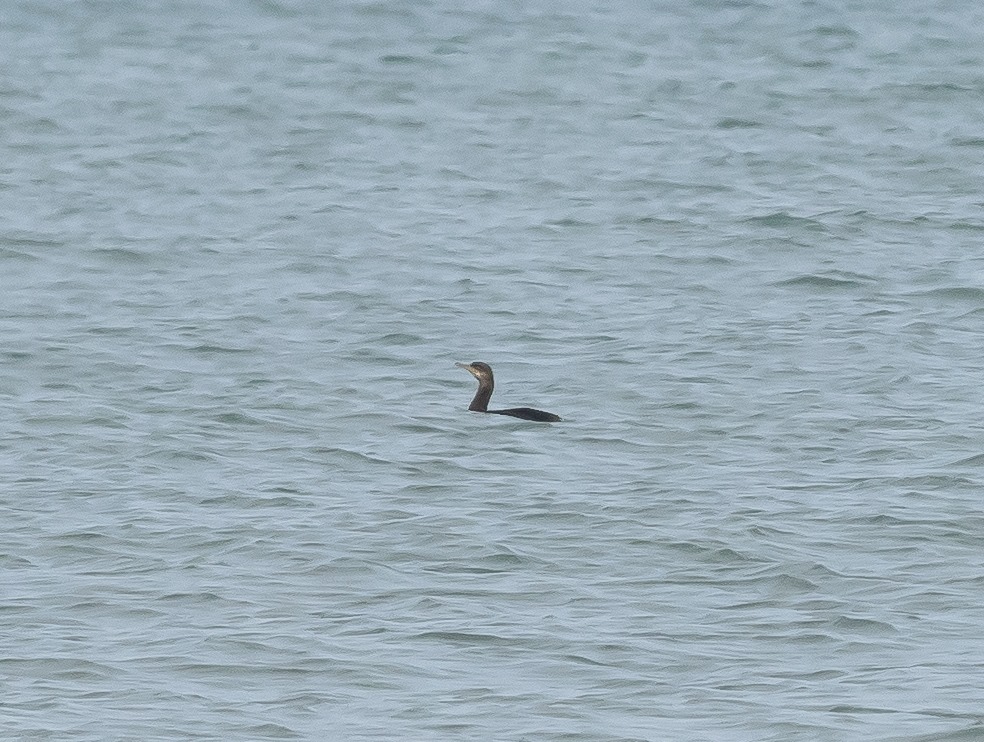
Without much more luck at this location we headed off to the next field where we were able to find 5 more snipes, but once again we were unable to connect with anymore. We then began the trek all the way back to Skagen for out first Kabeltromelen round at 6 AM. What a night.
On a personal note, I wanted to thank everyone I have encountered at the station: the guests, my co-volunteers and of course Simon. These past few months have been a life changing time for me and I am so grateful to have been a part of this place. I wish everyone luck at the station. To my friends still at the station: LONG LIVE TORNSANGER! Go for some swims for me and please find some good birds -- I'll be watching the blog and DOF Basen.
And so my time at SKAF has passed (for now), what will tomorrow bring for the rest of the volunteers? Read tomorrows blog to find out. But for now I bid you all farwell!
Vi Ses
Lucas Corneliussen
Ringing (Kabeltromlen)
Willow Warbler (Løvsanger) - 4
Common Whitethroat (Tornsanger) - 4
Chiffchaff (Gransanger) - 1
Marsh Warbler (Kærsanger) - 2
Total: 11
People at SKAF: Lucas Corneliussen, Rosa Hicks, Ragnar Smith, Simon S Christiensen, Andrew Commins, Joe Zeno
Barred Warbler, European Shag and Pizza//You can't have you crake and eat it too
Finally! Today was a proper Skagen-autumn day birdwise. After a night ringing session that resulted in a Common Redshank (Rødben) 1k and a European Nightjar (Natravn) and Aurora Borealis! Lucas paid for it with a facial roadrash when he crashed his bike on his way out to Grenen with Rosa.
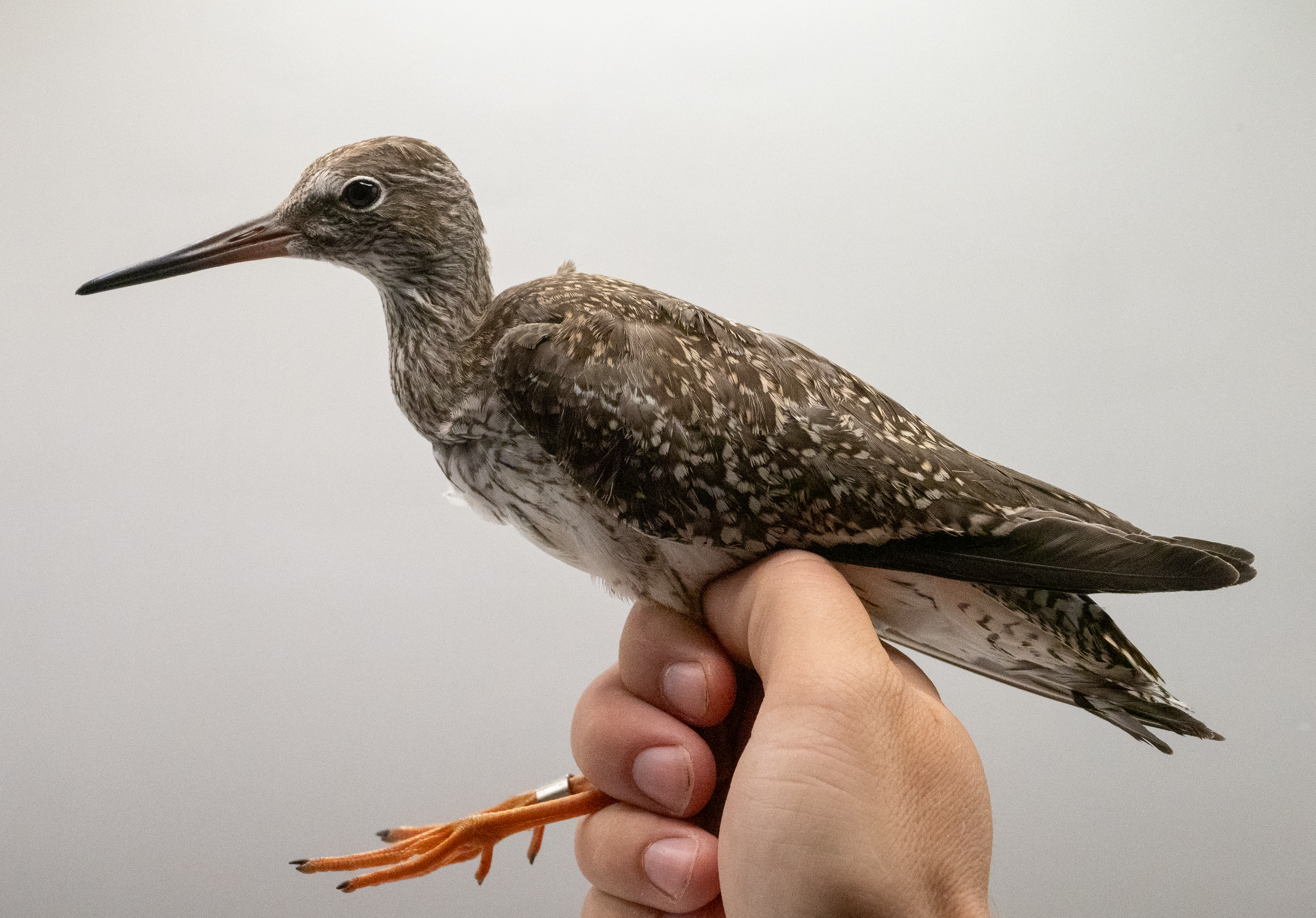 Redshank (Rødben) 1k
Redshank (Rødben) 1k
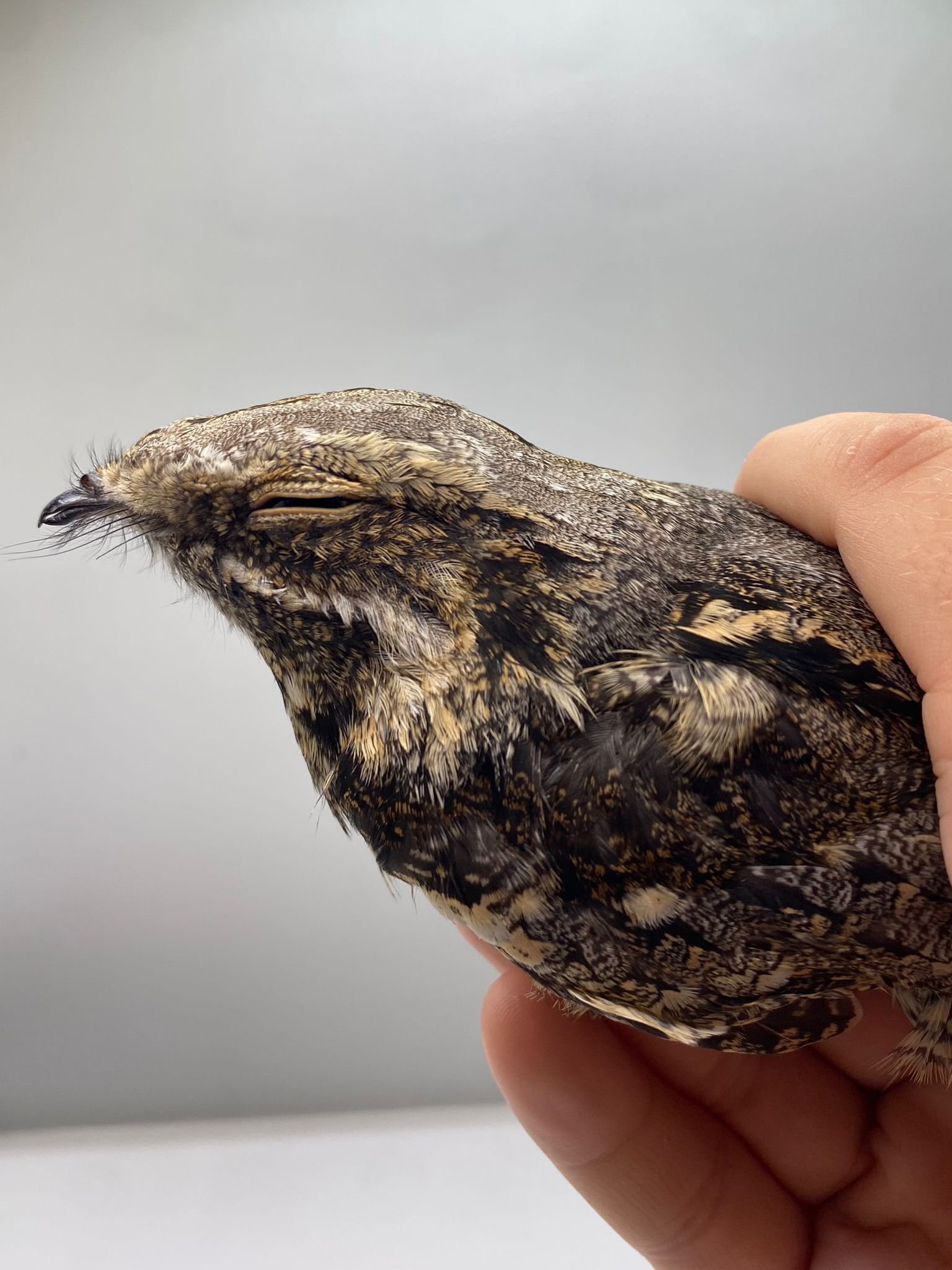 European Nightjar (Natravn)
European Nightjar (Natravn)
Morning observation was somewhat quite numberwise, but the diversity was good for once! I was joined by visiting birder Nicolaj, which is always very welcome, it can be a bit lonely in the dunes, especially when the birds are lacking. The birds of the day were three mediterranean gull (Sorthovedet Måge) 1k, one Caspian Gull (Kaspisk Måge) 3k and Rolf found a European Shag (Topskarv) that landed out by the tip and kept us company. But the bombshell fell when Nicolaj said he thought he had received a Zello call, so I checked my phone and saw I had five missed calls, two Zello calls and a SMS message with word “BARRED WARBLER” across my screen. I told Nicolaj and we moved to Kabeltromlen and were presented a very nice Barred Warbler (Høgesanger) 1k. 55th record for Skagen a new bird for all the volunteers, excluding me, this was my third autumn record, but I have never seen one in hand, what a stunner!
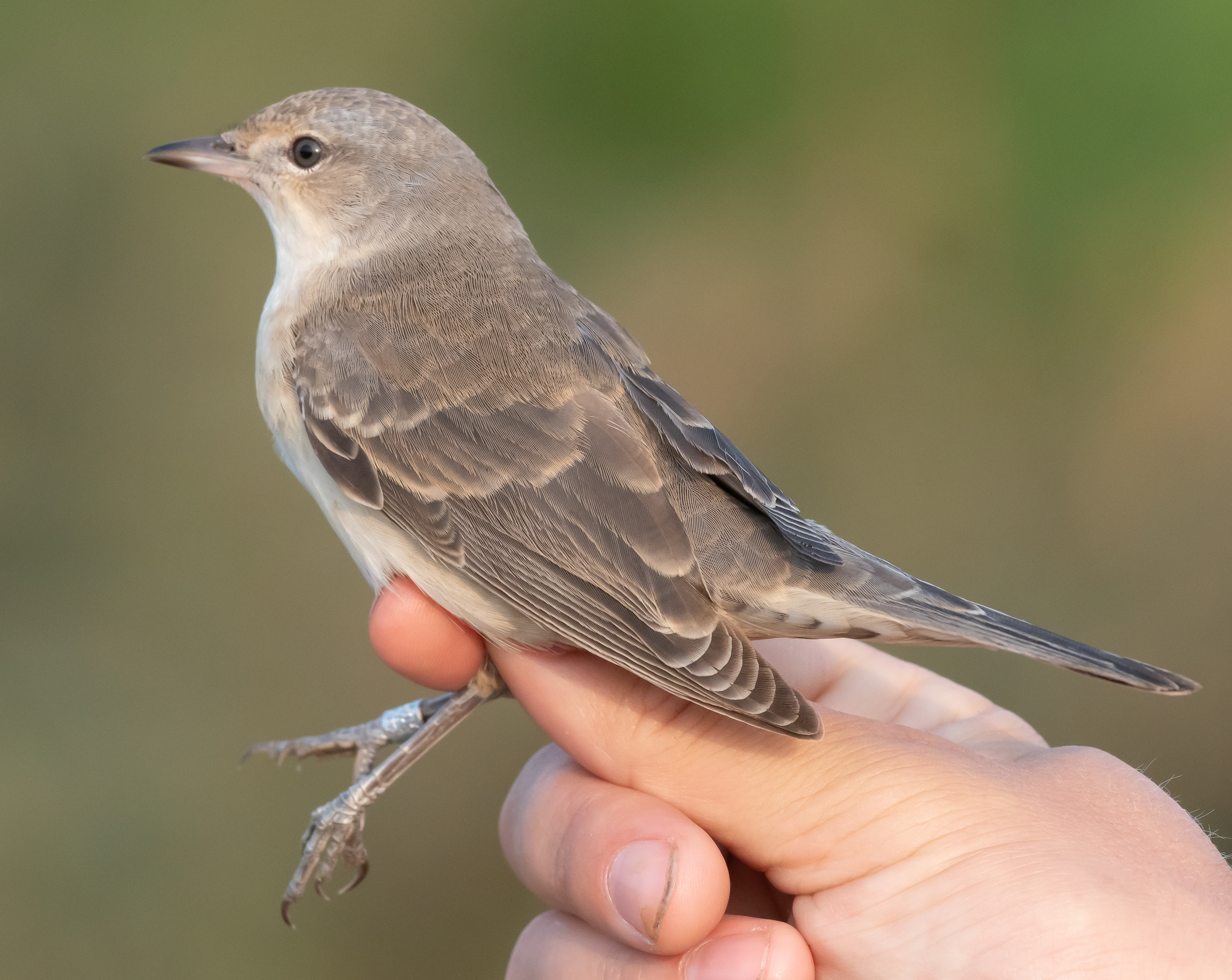 Barred Warbler (Høgesanger) 1k
Barred Warbler (Høgesanger) 1k
Otherwise, it was somewhat quiet, though a visit at the stationary Zitting Cisticola (Cistussanger) that has been there for four days and has proven quite popular lifted my tired but content spirit. The rest of the day was doing light work and greeting our new guest Susanne and Torben, they are going to stay here for a week. Simon came by for the evening meeting and then him and the rest of the volunteers went to Gyvelmarkerne trying to look for Great Snipe (Tredækker), which ended with a Eurasian Bittern (Rørdrum) and the potential hit of the day a probable Spotted Crake (Plettet Rørvagtel) 1k they flushed a few times.When they came back we out for some dinner and ended up at a very nice pizzeria.
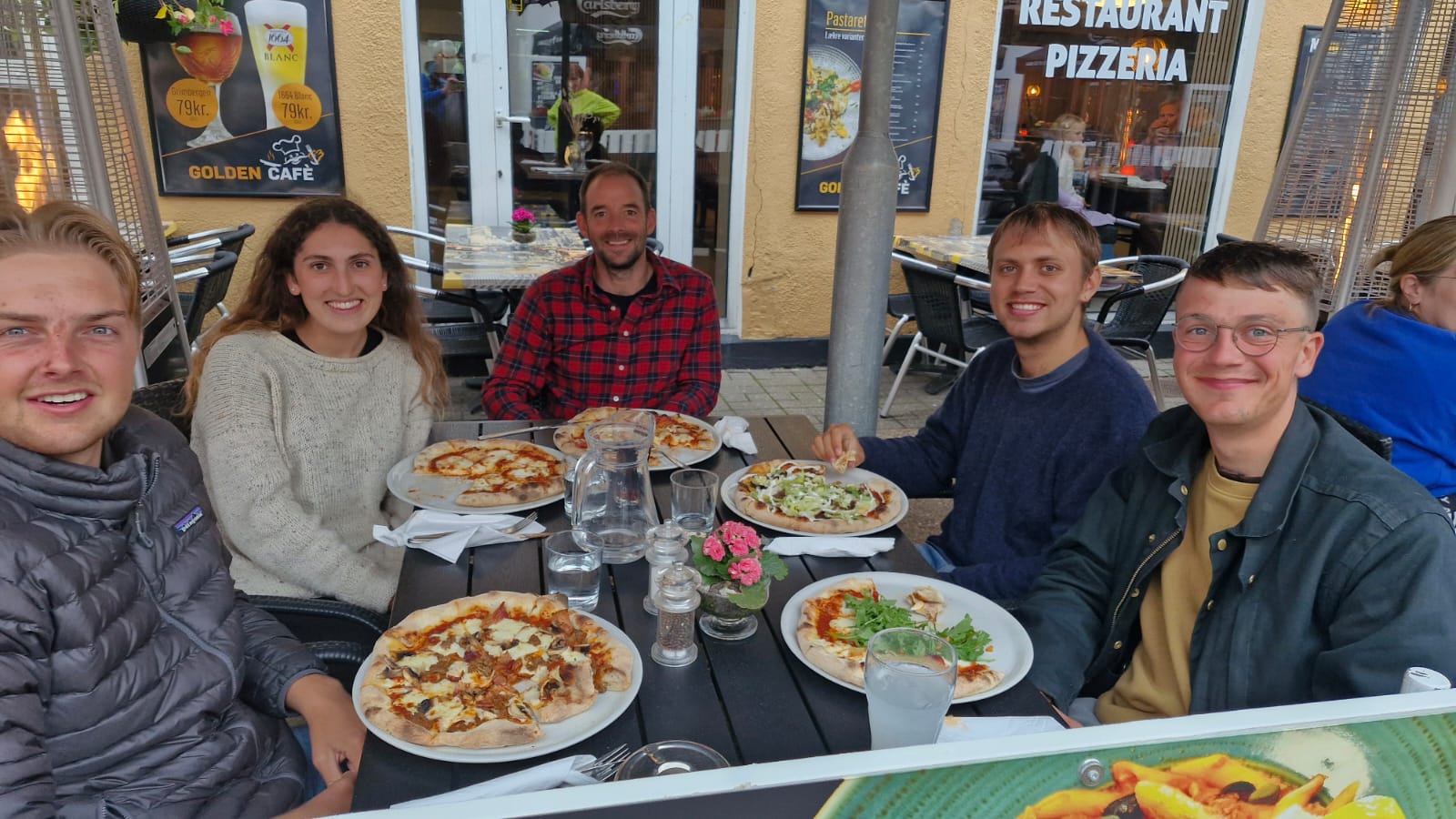 Pizza-party
Pizza-party
After that me and Simon went back to Gyvelmarkerne with flashlight, thermal monoculars and a handnet to see if we could catch the crake. Though we didn’t succeed, we were very, very close to catching it as it ran around in the very tall grass 1-2 meters in front of us, but we didn’t “take the shot” so to speak. It would have been the perfect cherry on top of a very good ice cream!
Ringing (Kabeltromlen)
Rødstjert (Common Redstart) - 1
Kærsanger (Marsh Warbler) - 3
Rørsanger (Reed Warbler) - 1
Tornsanger (Common Whitethroat) - 2
Munk (Blackcap) - 2
Løvsanger (Willow Warbler) - 1
Grå Fluesnapper (Spotted Flycatcher) - 1
Total: 11
Link to todays observations from observers in the area
People at the station: Ragnar Smith, Joseph Zeno, Lucas Corneliussen, Rosa Hicks, Simon Siggaard Christiansen, Nicolaj Jeppesen, Torben Præst, Susanne Præst, Peter Sørensen, Rosalina Leth-Nissen et. al.
The cistussanger continues
Howdy!
I was at World’s End 3 today, conducting morning observation with Ragnar. The winds were light and coming from the southwest, bringing a sharp coldness to our post on top of a sand dune. The morning started slowly, but we were happy to see two Mediterranean gulls and a juvenile Caspian gull on the beach. Barn swallows were making migration attempts, and several western yellow wagtails were flying overhead. A raven also flew overhead and said hello! This was one of our first days where zero fulmars were observed over the ocean. We observed a third calendar year of arctic skua chasing terns around the beach's edge.
After returning from the CES site yesterday, the ringers were back out at Kabeltromlen. The highlight observation from the ringing site was a continuing Zitting Cisticola heard near the nets. A highlight bird that was ringed today was a Northern Wheatear. Willow warblers, reed warblers, and marsh warblers were among other birds that flew into the nets today.
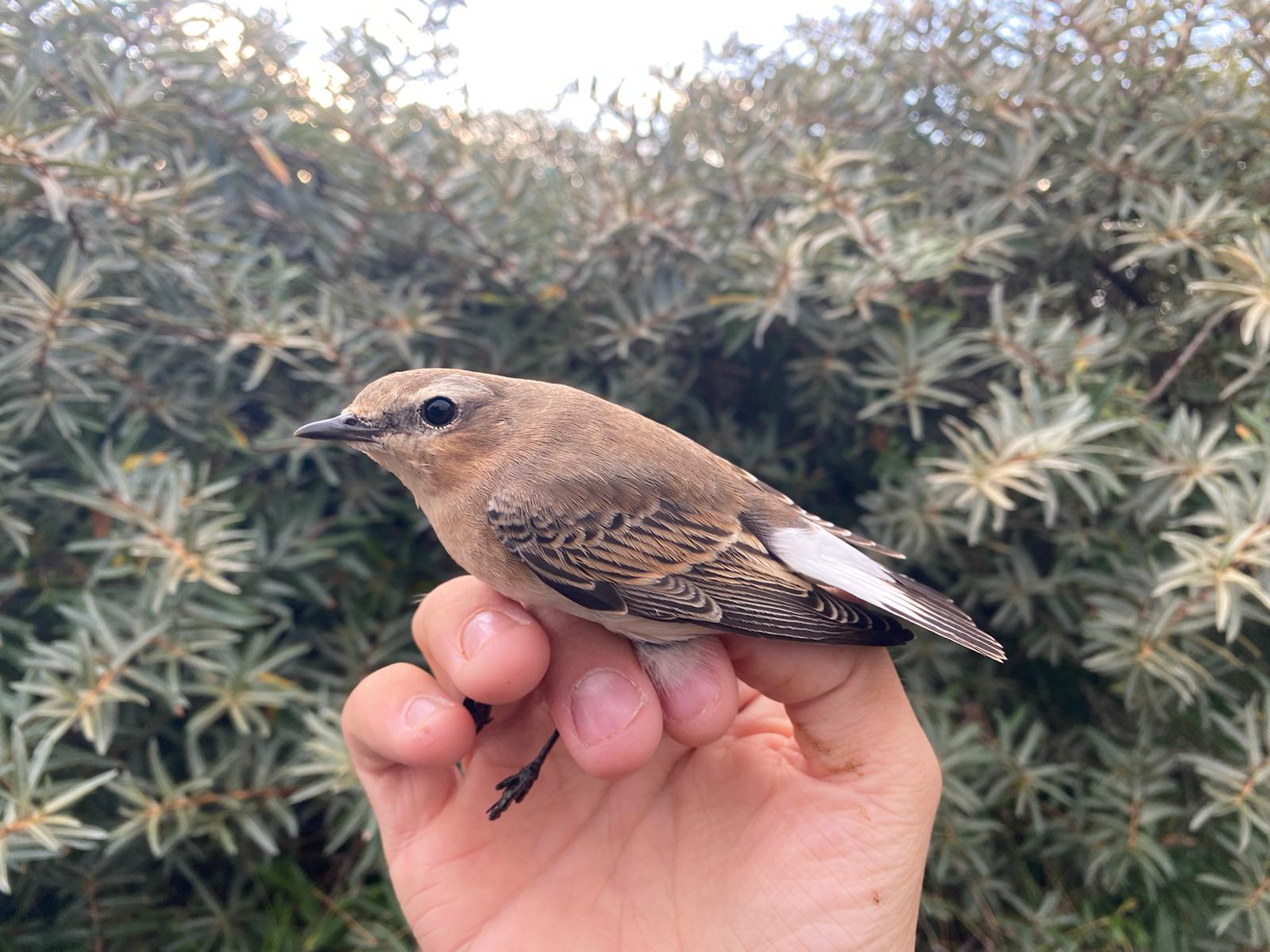
A Northern Wheatear was a highlight for the ringers today
After a long morning of ringing and observation, the guests, Grethe and Stig, who had prepared a lovely brunch, welcomed us back to the station. Scrambled eggs, bacon, and avocado bread filled our hungry stomachs. Thank you to the guests for that wonderful brunch!

SKAF guests enjoying brunch
Saturday is the station's weekly cleaning day, so we split up tasks and successfully brushed and scrubbed every nook and cranny of every room. The place is spotless now, and it will hopefully remain that way for a couple of days.
We are mist netting for storm petrels and nightjars tonight, so hopefully, the winds will bring us good luck!
Ringing (Kabeltromlen)
Stenpikker (Northern Wheatear) - 1
Kærsanger (Marsh Warbler) - 2
Rørsanger (Reed Warbler) - 3
Gærdesanger (Lesser Whitethroat) - 2
Tornsanger (Common Whitethroat) - 3
Munk (Blackcap) - 1
Løvsanger (Willow Warbler) - 3
Total: 15
People at SKAF: Joe Zeno, Ragnar Smith, Lucas Corneliussen, Rosa Hicks, Andrew Commins, Simon S. Christiansen, Grethe and Stig, Rosalina Leth-Nissen
CES SUCCESS!!
Another day, another CES visit. This was our eleventh visit of the year at our site and it was actually extremely productive today. We (Rosa, Andrew and yours truly) left the station at 04:30 AM to open the nets by 05:15 AM (we were a few minutes late, but oh well). The morning started out slow with only a few birds but we were hoping for more. Over the next few rounds we averaged around 4 birds in he nets each round but then around 08:30 during our fourth round we had a very large round of nearly 20 birds. This was one of the largest rounds in the past few months which was quite exciting. Birds are moving!!! Highlights from this morning included 4 Blåmejse (Blue Tit), 2 Rørspurv (Reed Bunting) and 13 Rørsanger (by far the most common bird at Skarvsøen).
The day started out a bit different for Joe. He was supposed to leave today after booking a last minute flight back to California, however, our trusted and esteemed supervisor and dark night, Mr. Christiansen, overslept and forgot to pick Joe up to take him to the train station. So, Joe gets to stay at the station for a few extra days after all. Fortunately, he was able to get refunded for the majority of the ticket, so no harm no foul.
Ragnar also had a nice day on observation this morning. Despite a slow time with seabirds (havfugle), he had lots of migrating waders including Dværgeryle (Little Stint) and Temmincksryle (Temminck's Stint). Along with the waders, two Mediterranean Gulls (Sorthovedet Måge) on the beach were another nice surprise.
Sorthovedet Måge (second from the left)
In the evening, we had our meeting and then decided to go to the beach and play volleyball. Thank god we were hired for our birding skills and not our volleyball skills because I think most of us would swiftly get fired. Tonight we are going out to Grenen to try and catch roosting waders! Wish us luck! And so, another day passes at Skagen Fuglestation. What will tomorrow bring? We will have to wait and see.
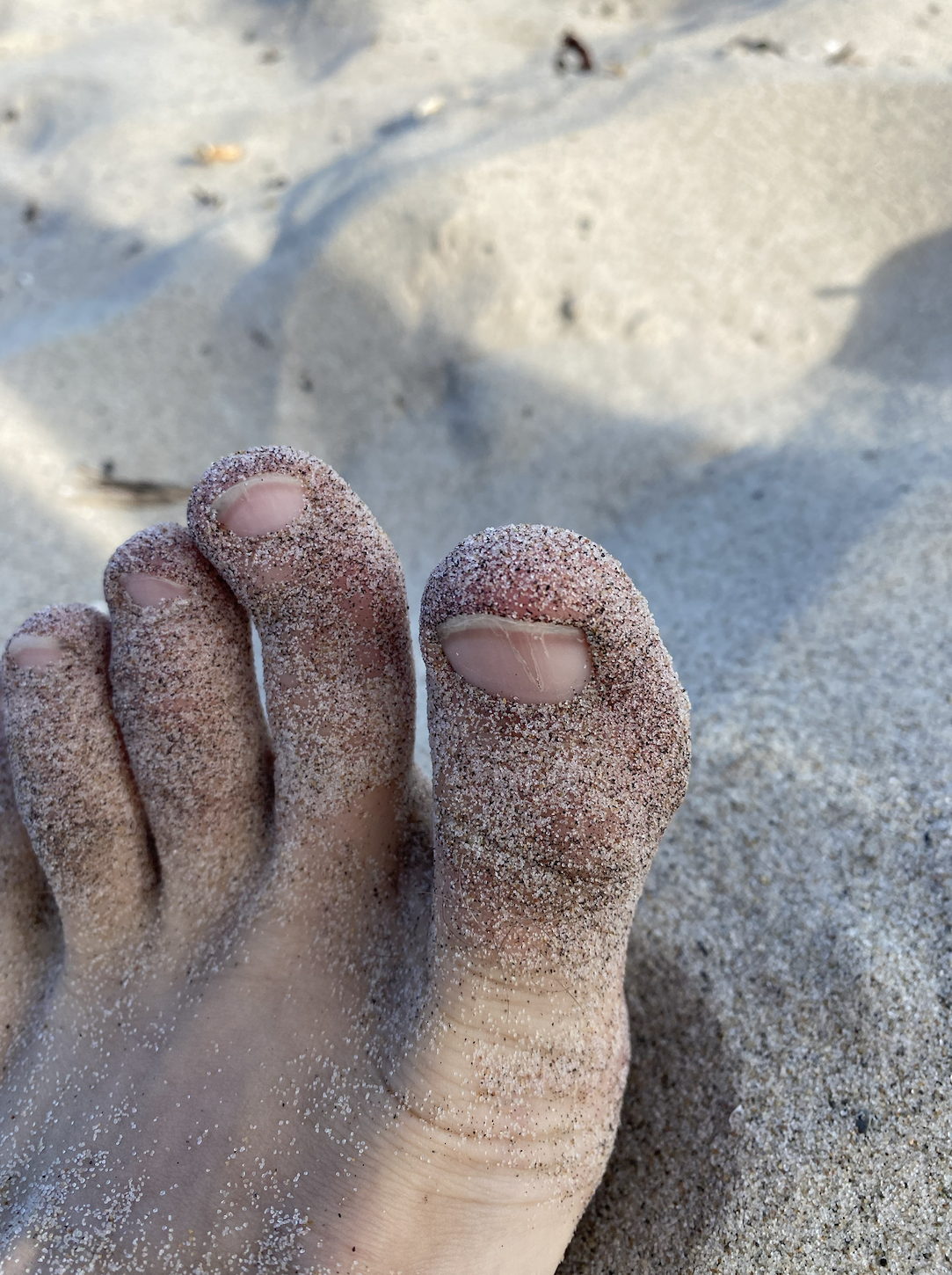 TRIGGER WARNING! (Ragnar's Sandy Toes - post Volleyball)
TRIGGER WARNING! (Ragnar's Sandy Toes - post Volleyball)
Vi Ses
Ringing (Skarvsøen)
Blåmejse: 4
Rørspurv: 2
Rørsanger: 13
Kærsanger: 2
Tornsanger: 4
Havesanger: 2
Løvsanger: 2
Gransanger: 1
Gærdesanger: 1
Total: 31
Link to today's observations on Dofbasen
People at SKAF: Lucas Corneliussen, Rosa Hicks, Andrew Commins, Ragnar Smith, Simon S. Christiansen, Grethe and Stig
Lammergeier Lammergone??
Hi folks,
We start todays blog with last night. As Simon, Andrew, Lucas, and I went out to the tip for some night catching of waders, dazzling two dunlin (Almendelig Ryle).
The crew started the day with the usual standardized ringing and observations. The ringing team had a good day with a total of – birds, mainly consisting of young common whitethroats (Tornsanger) and willow warblers (Løvsanger). A first-year spotted flycatcher (Grå Fluesnapper) was a first in the hand for Andrew and a lovely final bird for Asia, as she sadly left the station today – her equal passion for birds and toast will be missed by all!
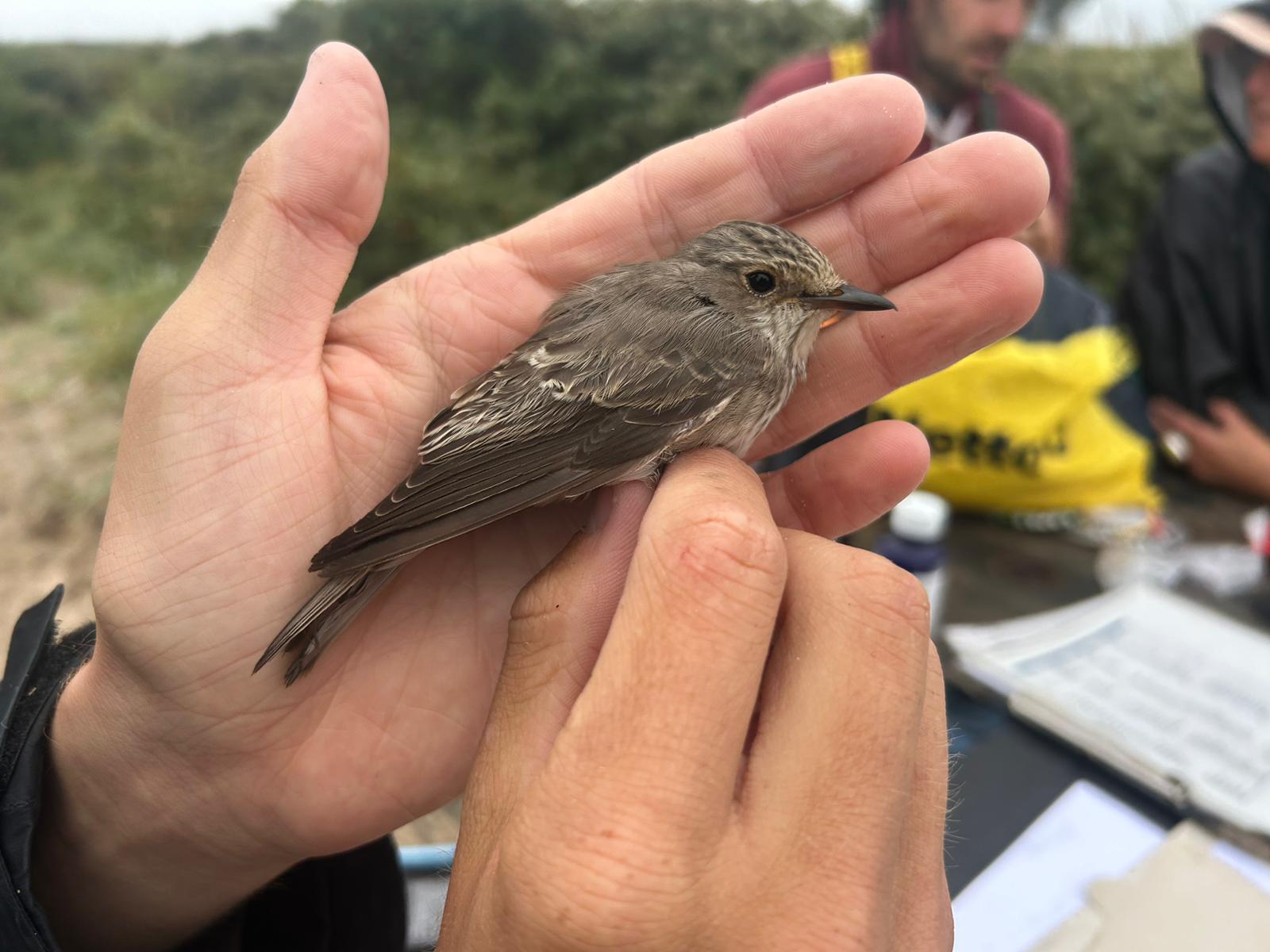 Spotted Flycatcher (Grå Fluesnapper), rung at Kabeltromlen.
Spotted Flycatcher (Grå Fluesnapper), rung at Kabeltromlen.
While most of us were busy at Kabletromlen, Ragnar was out at the Sandworn Track, desperately trying to pick out some migration from the fog. He managed some waders, including curlew sandpiper (Krumnæbbet Ryle), whimbrel (Småspove), little stint (Dværeryle), Temminck’s stint (Temmincksryle). It was nice to hear news that the zitting cisticola (Cistusanger) remained in the area too. Turning his attention to passerines, Ragnar visited Elle Krattet once the main counting was over, finding pied and spotted flycatchers (Broget Fluesnapper & Grå Fluesnapper), with additional reports of a wood warbler (Skovsanger) coming in from the area too.
After some delicious pancakes cooked by Lucas and a bit of data entry, we headed over to Buttervej to look for passerines, following Ragnars earlier successes. Spirits were high, as Joe performed back-to-back renditions of Taylor Swifts’ red album, which manifested into two juvenile red-backed shrike (Rødrygget Tornskade). Also spotted were goshawk (Duehøg), golden plover (Hjeile), and crested tit (Topmejse).
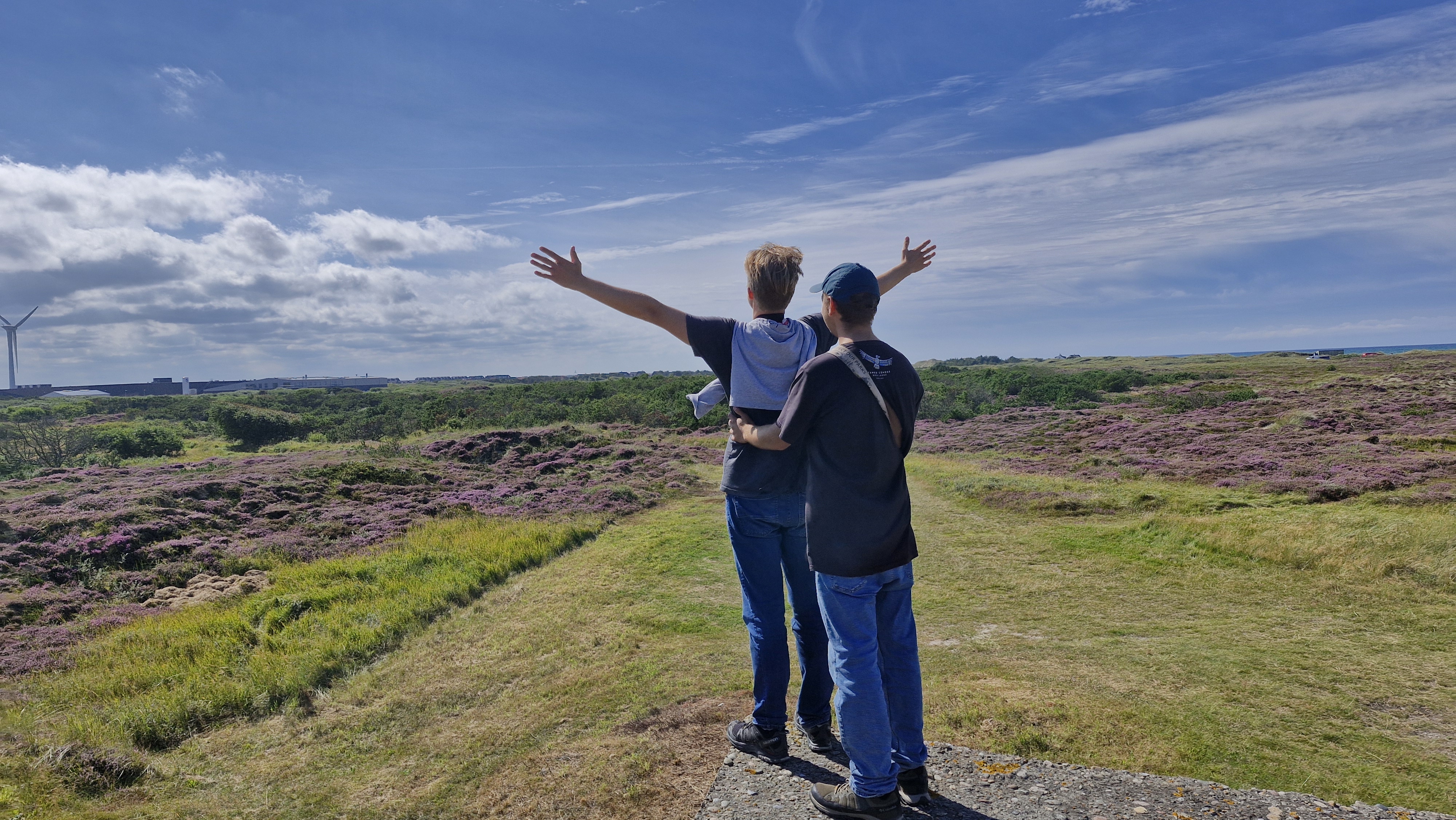 Joe and Lucas enjoyoing the view and passerines at Buttervej
Joe and Lucas enjoyoing the view and passerines at Buttervej
We then had the exciting news of a possible lammergeier (Lammegrib) a few miles South, so we pedaled our way to Hulsig. After an hour or so of meticulously scanning the dunes, the hunger had kicked in and so we returned to the station for dinner. Fingers crossed the mystery bird gets resighted!
Ringing (Kabeltromlen)
Vandrikse 1
Kærsanger 1
Tornsanger 9
Gærdesanger 1
Gransanger 4
Løvsanger 3
Grå Fluesnapper 1
Havesanger 1
Munk 3
Total: 24
Link to today's observations on Dofbasen
People at SKAF: Lucas Corneliussen, Rosa Hicks, Simon S. Christiansen, Asia Kane, Andrew Commins, Ragnar Smith, Joe Zeno, Grethe & Stig
CISTUSANGER!!!! Again??!?!?!
Today started off with a bit of a sad situation. Andrew and I woke up bright and early to check the weather forecast as we had seen the night before that there may be a thunder storm headed towards us. Unfortunately, the radar forecast was correct and we found ourselves staring at a lightning storm outside our window. And with that, we decided to delay opening the ringing nets for an hour. Then at 05:30 AM, we got up from our slumber once again only to find the radar to state that it would be torrentially raining in about an hours time. With that we called our Dark Night (Simon), and he made the executive decision to cancel ringing for the day. Ragnar, our bravest soldier, ventured off to Worlds End 3, after the heaviest rain had passed and proceeded to have a relatively slow morning. A single Northern Fulmar (Mallemuk), a few migrating waders, a migrating Garganey (Atlinand) were the highlights of the morning. By 9 AM, everyone at the station had re-arisen and we decided to open to Fyrhaven nets before the next rain storm came. Shortly thereafter, we had to close the nets after one round due to wind and rain. No birds. Saddened, we waited for the next part of our day -- but we were shocked to hear on Zello that another ZITTING CISTICOLA (Cistusanger) had been found at the Sandormentrak. All of us quickly got our gear and sped out the door. When we arrived a few minutes later, the bird took no longer than a minute before it began to sing and display in front of us. What a cool bird! This represents the 10th Country record for Denmark and the 9th in Skagen.
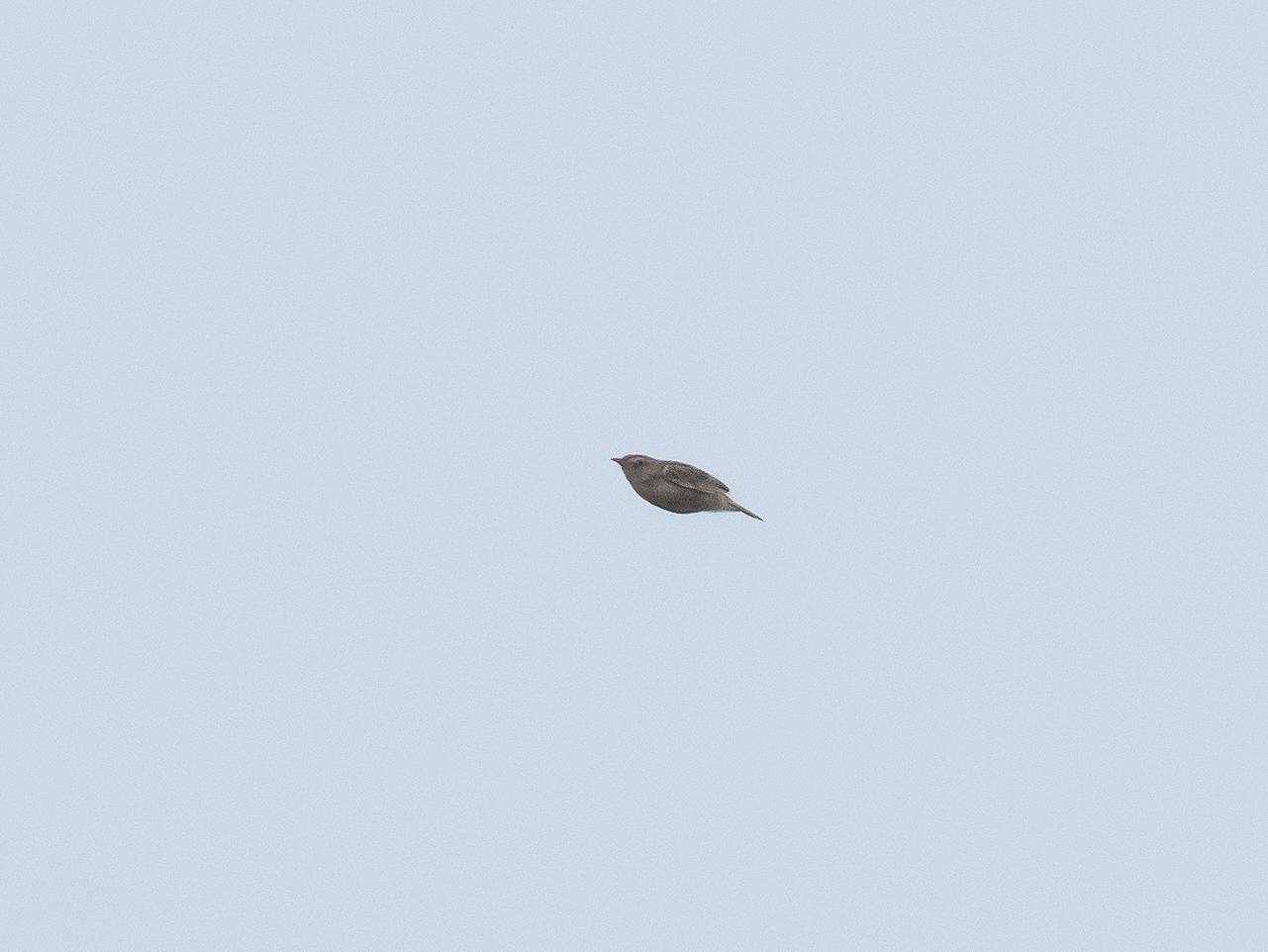 Cistusanger
Cistusanger
We then spent the next hour wandering around Grenen hoping to stumble across something else, but alas, our efforts turned up nothing else of note. Heading back to the station, we realized that we were getting very low on food, so Andrew, Joe and Ragnar commandeered Simon’s car and went and bought half of Lidl. That should last us all of 3 days! And we were delighted to received fresh havtorn marmelade made by out lovely guests.Then upon there return, we had a great session run by Simon on Skull Ossification and the process of using this method and how it is used. Tonight, we will head to Grenen with the hopes of catching waders in the night. And so, another day passes at Skagen Fuglestation, what will tomorrow bring? We will have to wait and see!
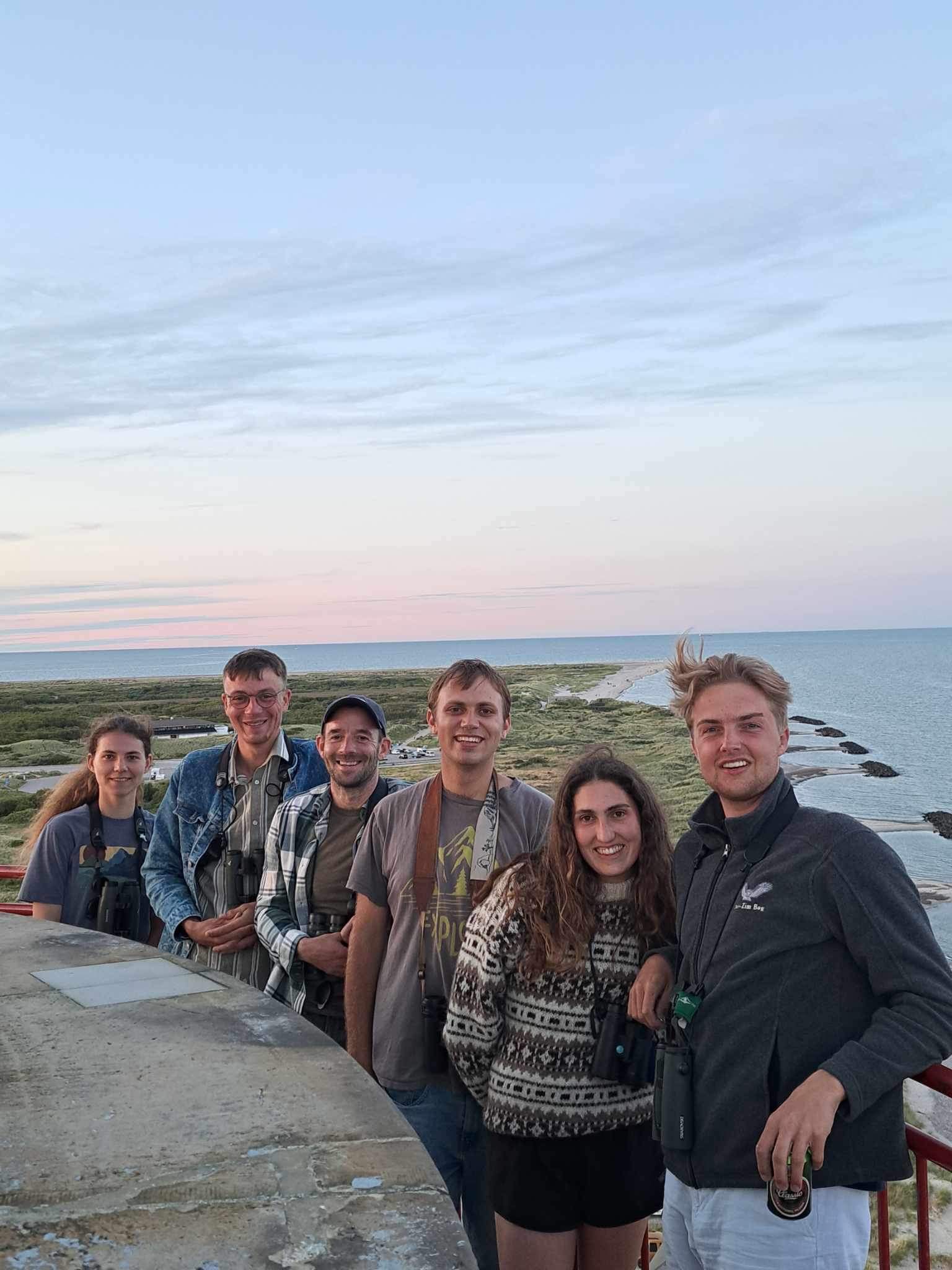
Vi Ses!
People at SKAF: Lucas Corneliussen, Rosa Hicks, Simon S. Christiansen, Asia Kane, Andrew Commins, Ragnar Smith, Joe Zeno, Grethe & Stig
